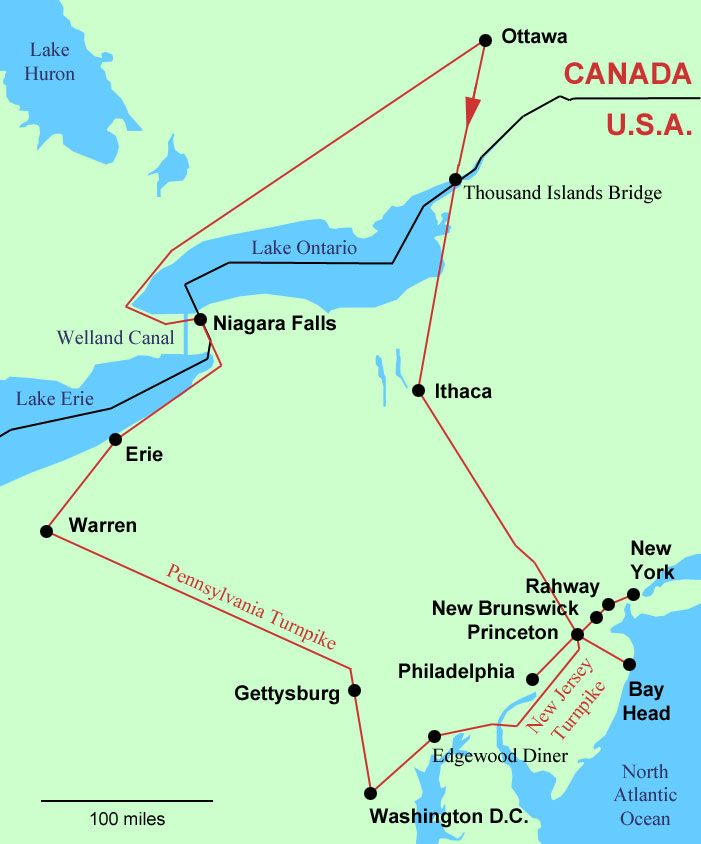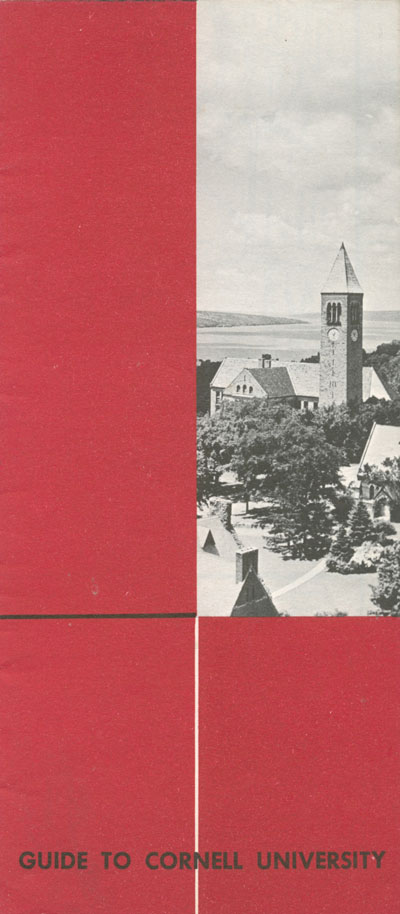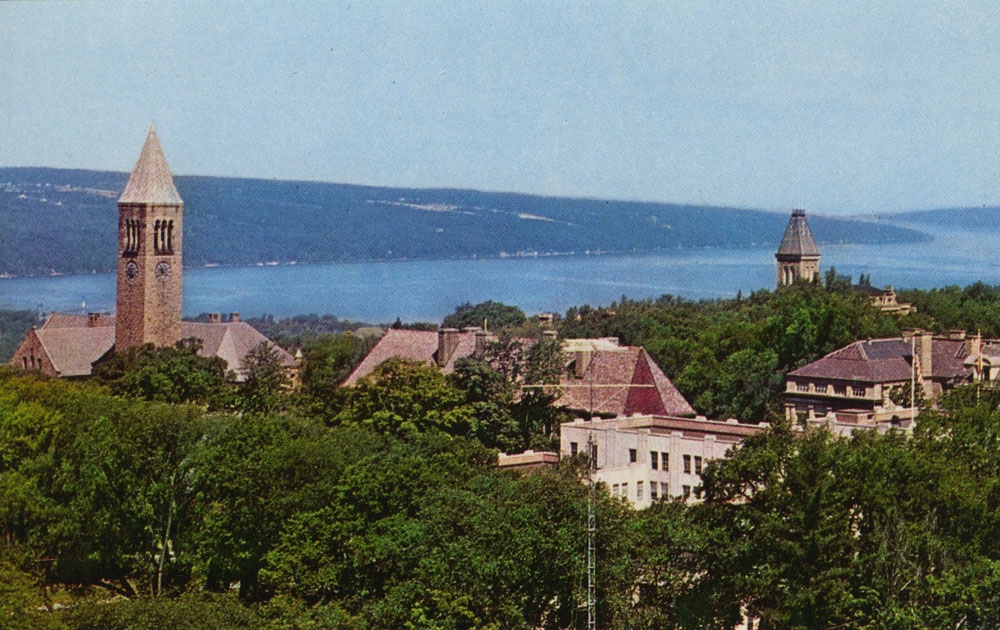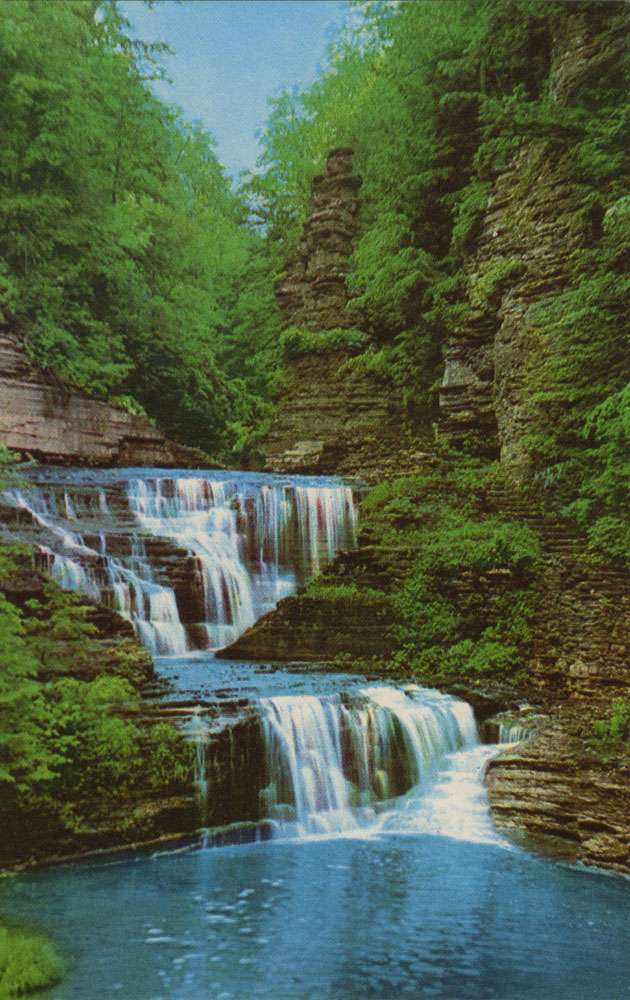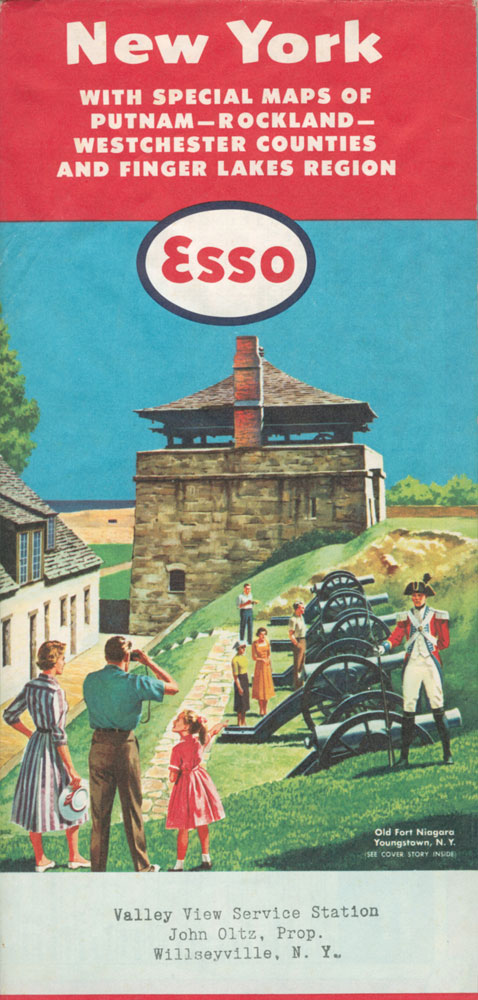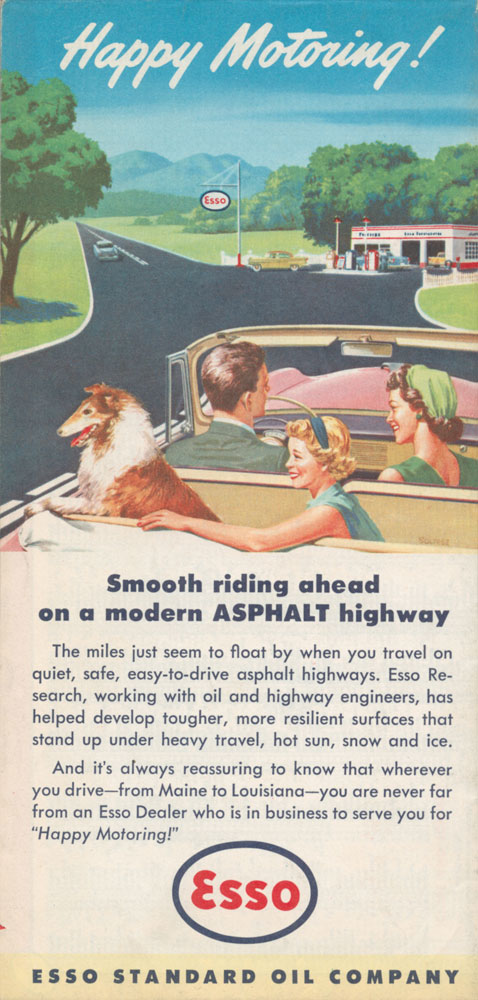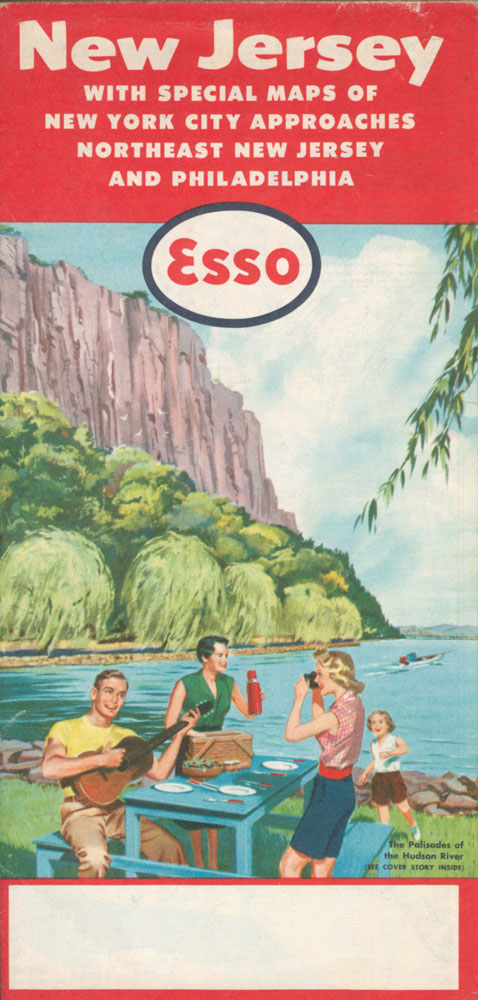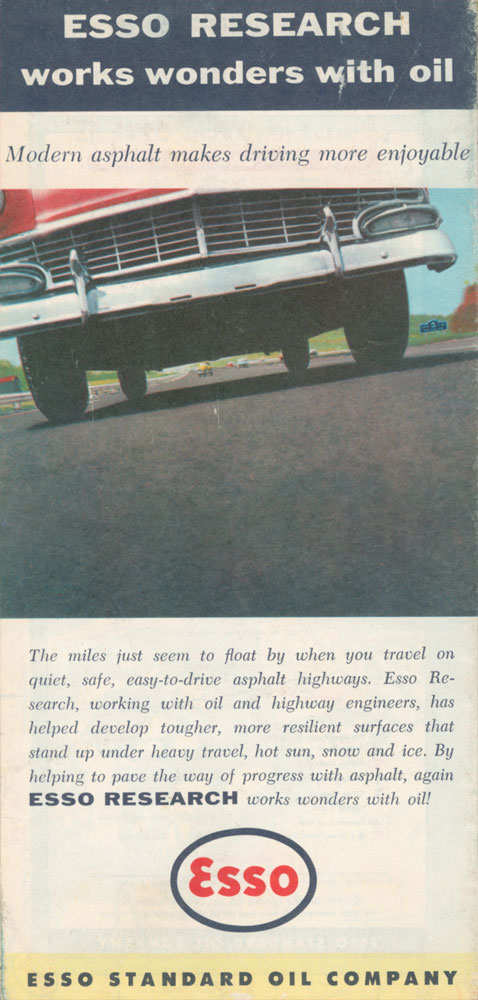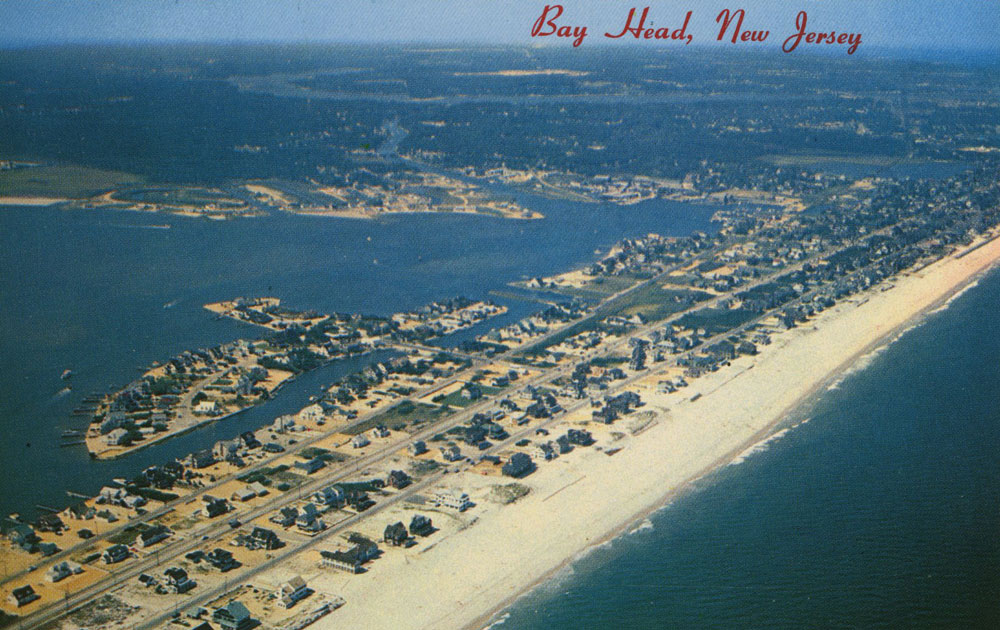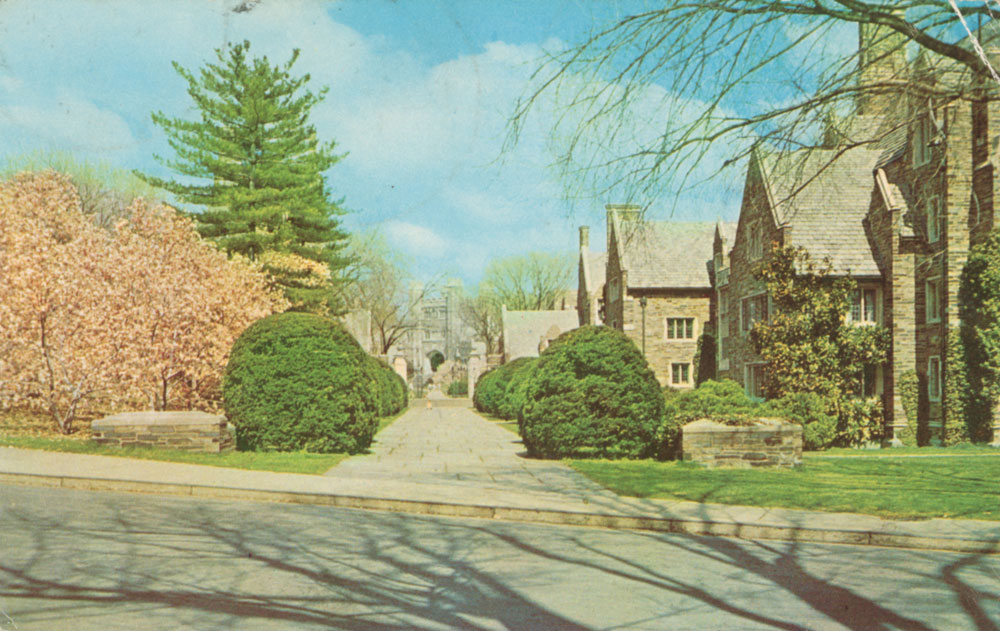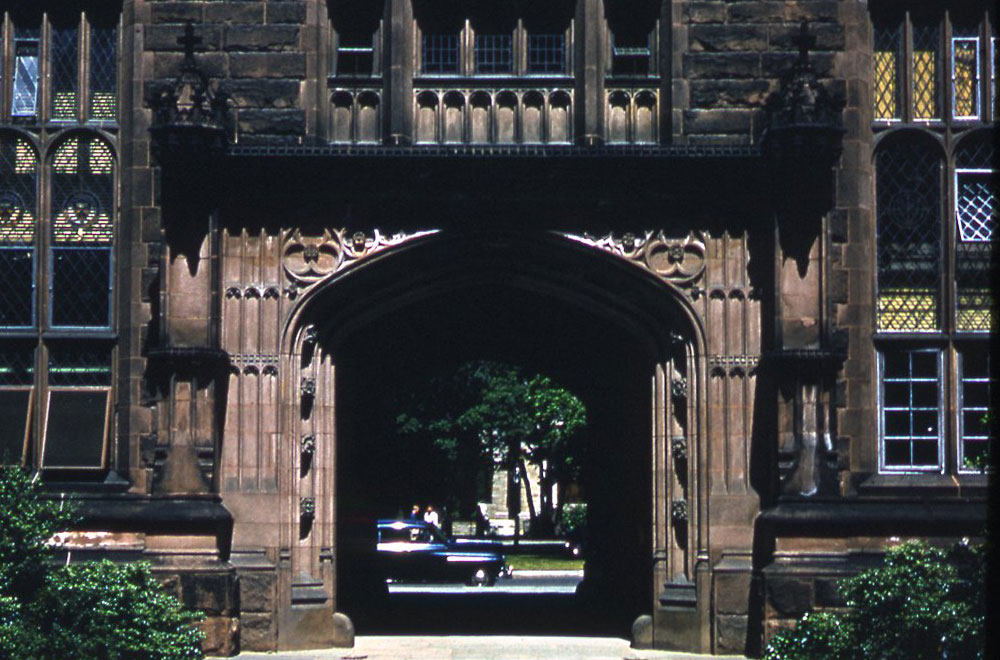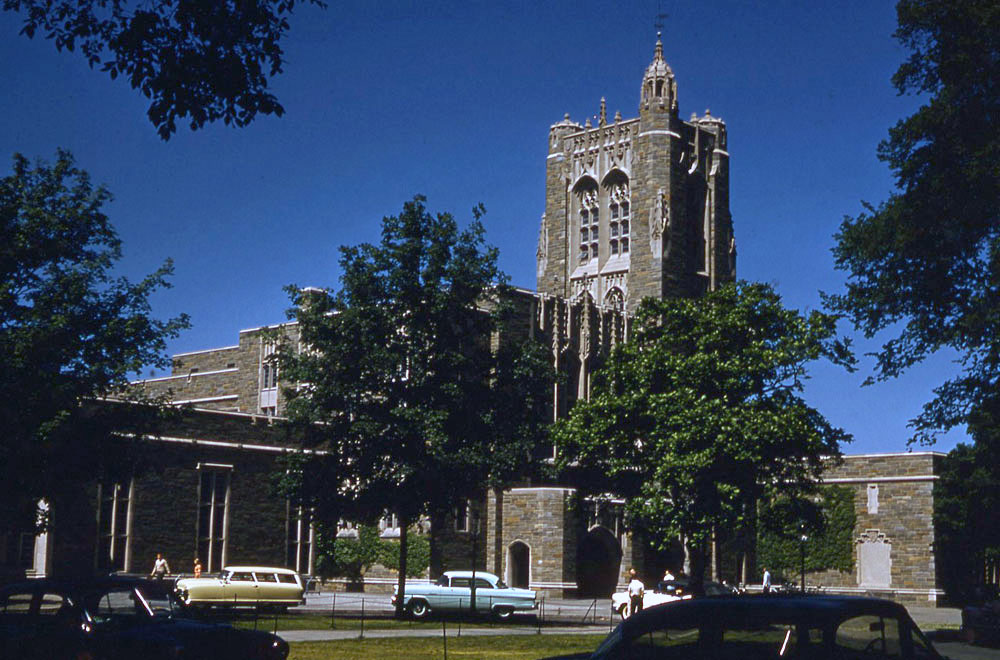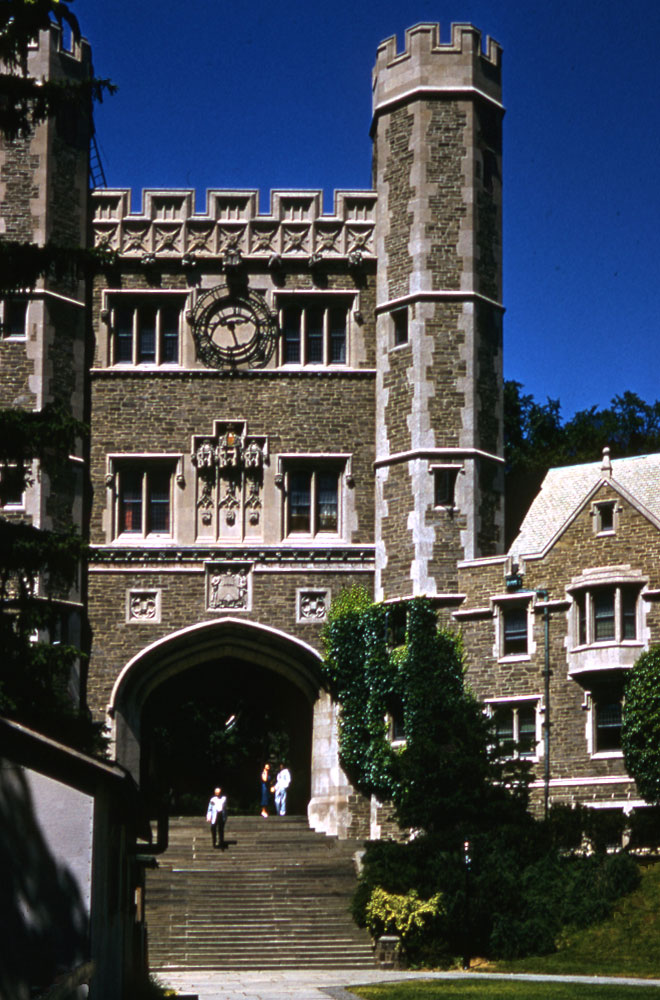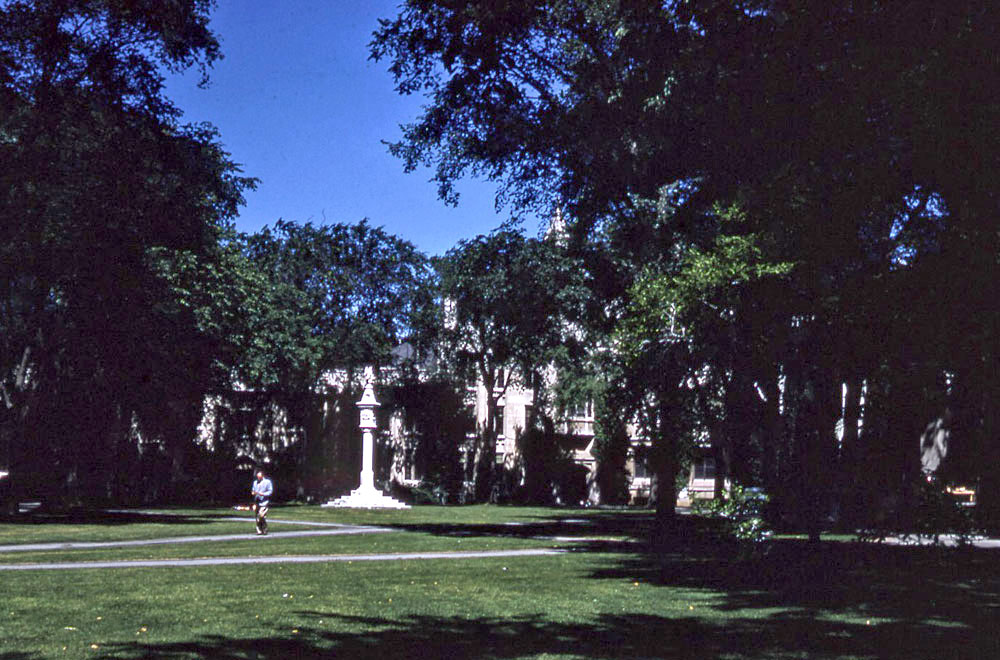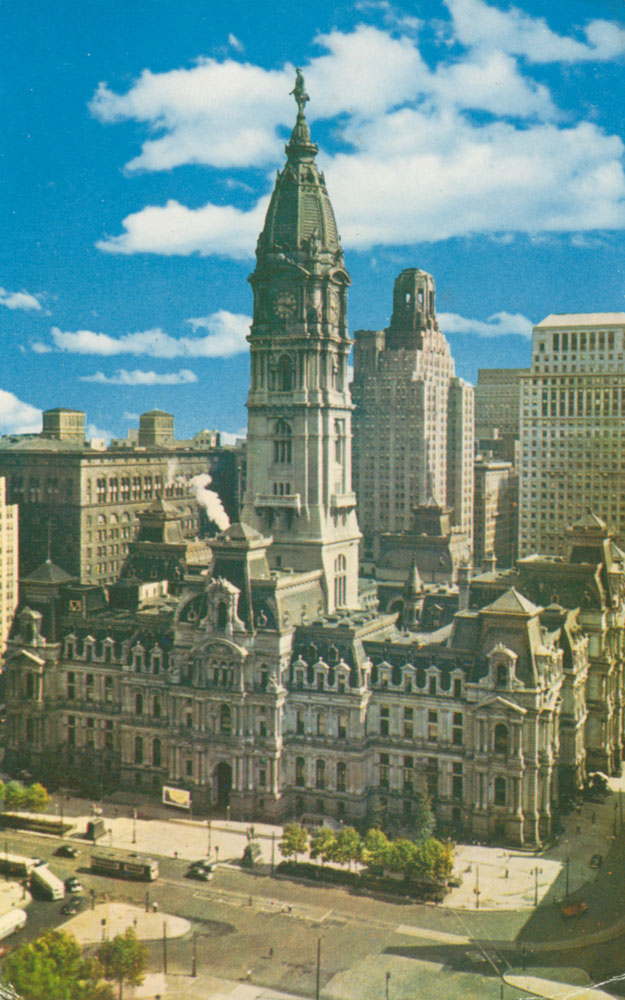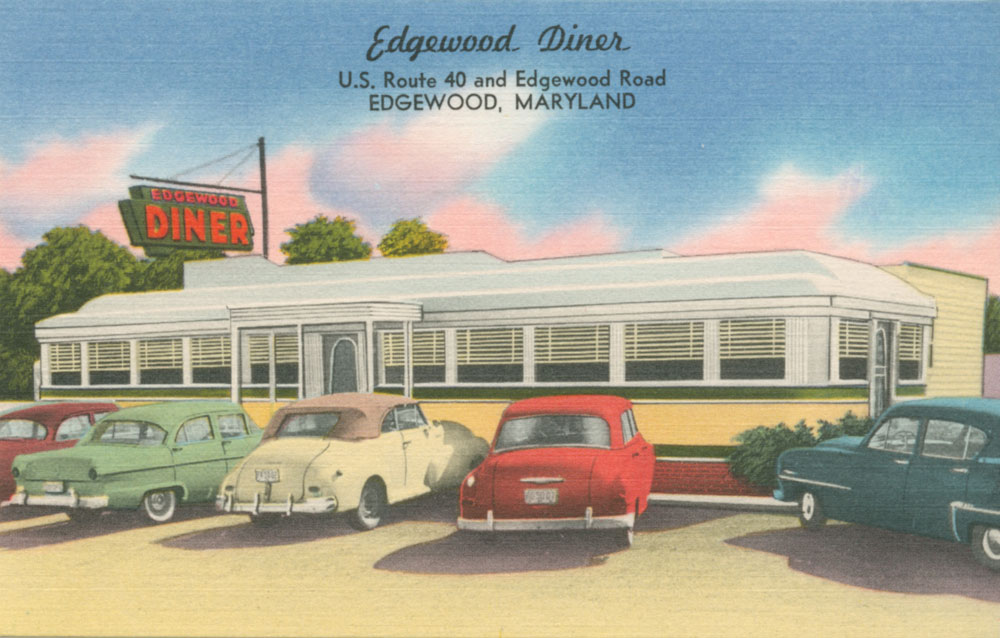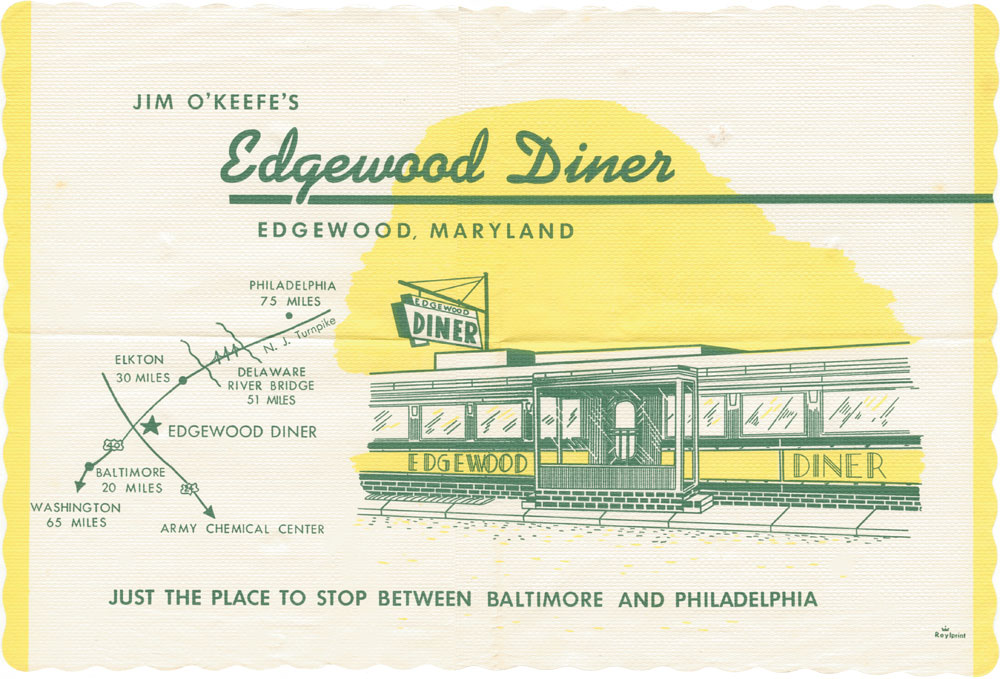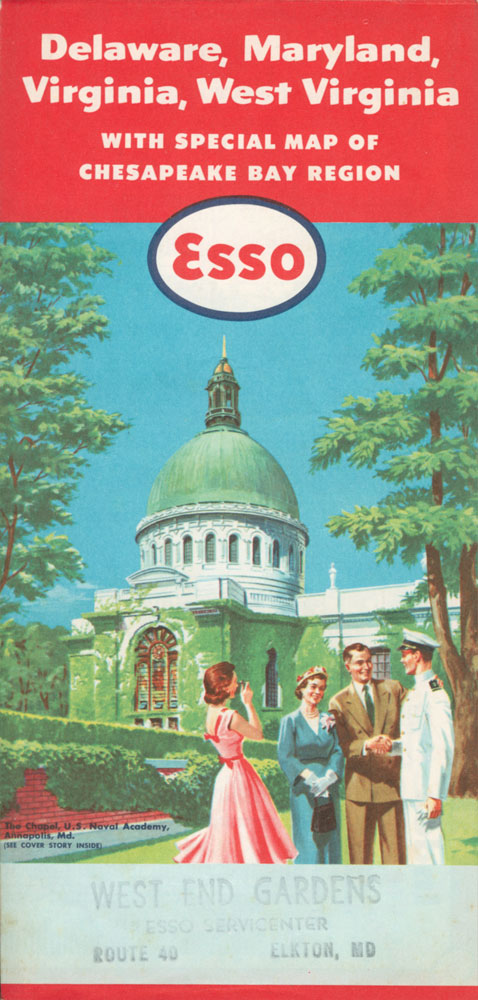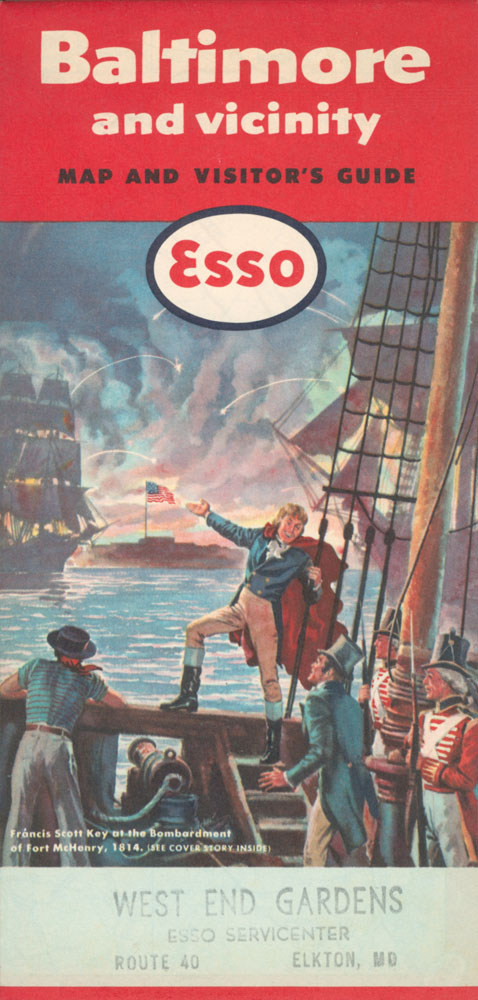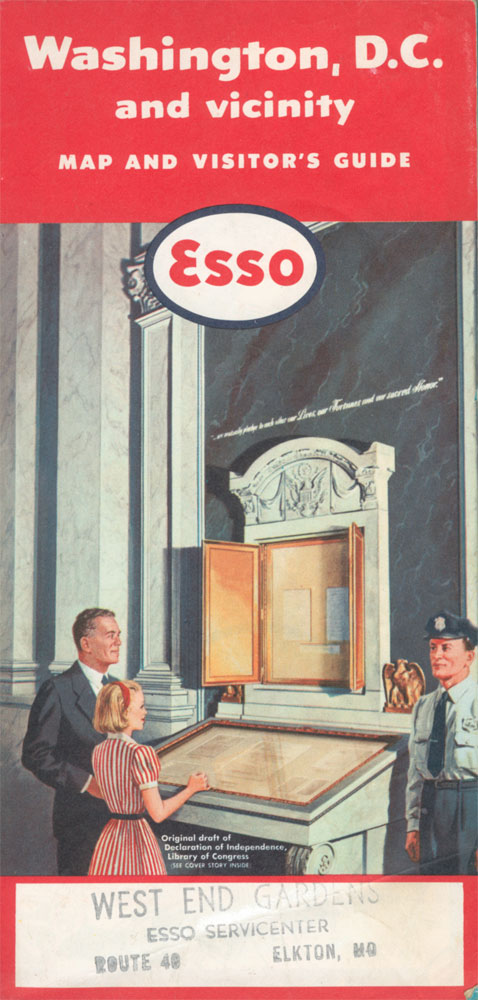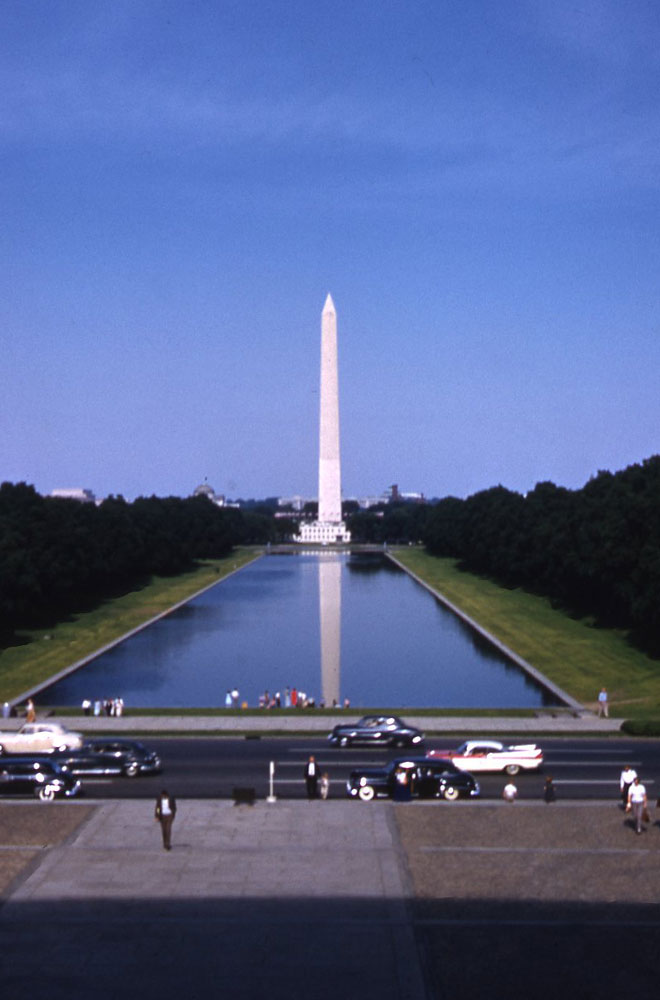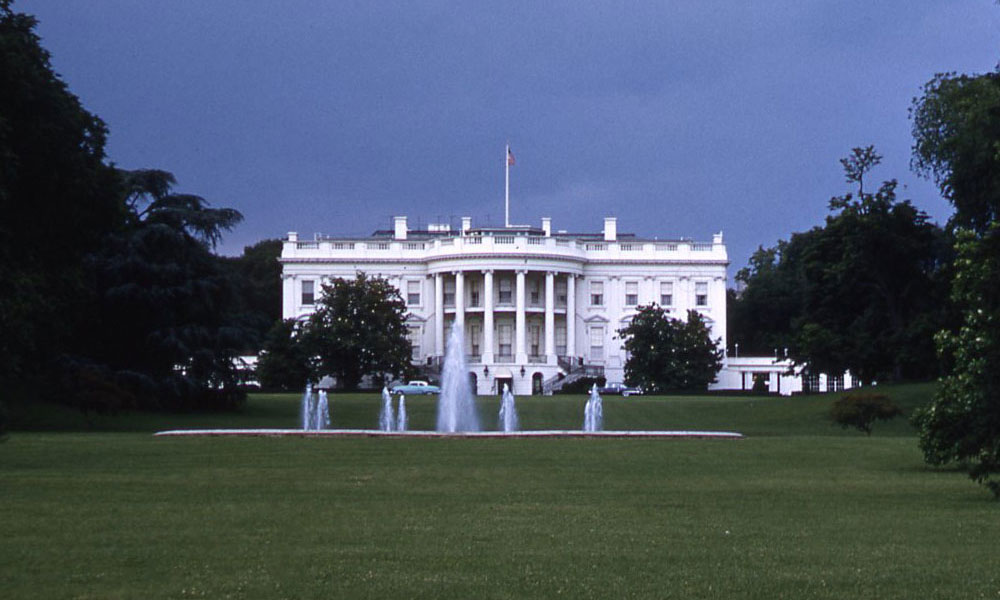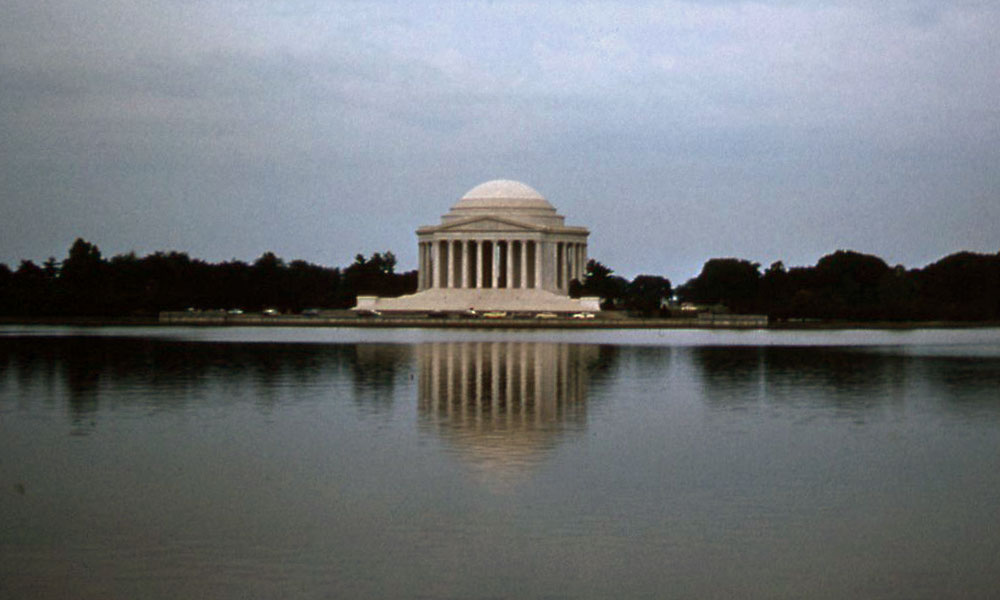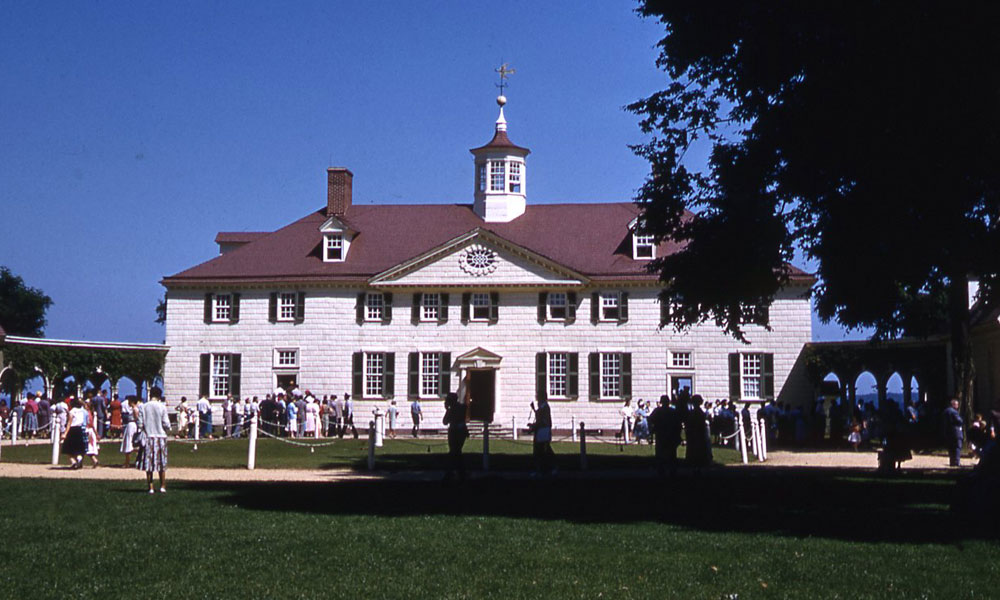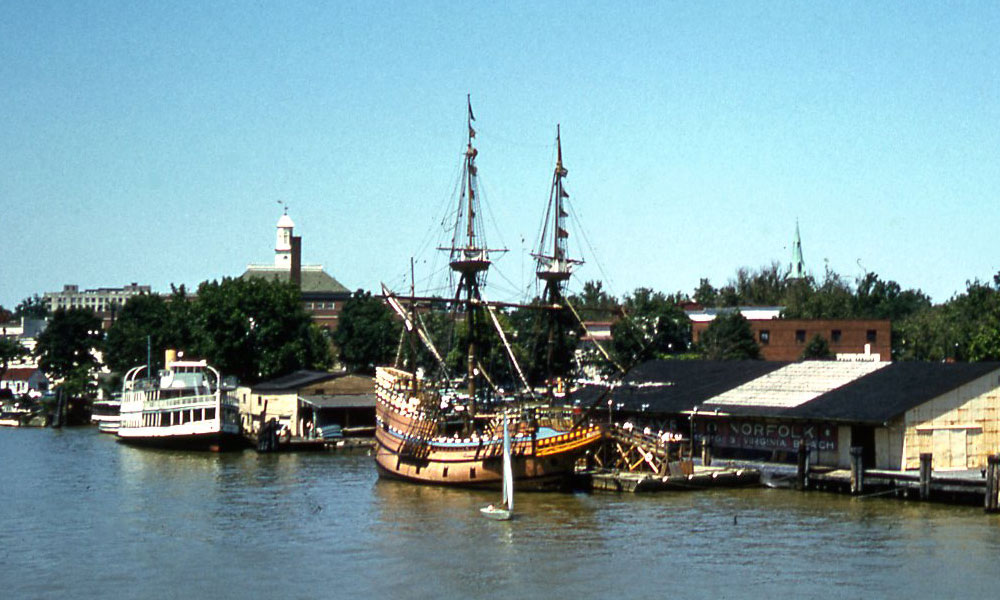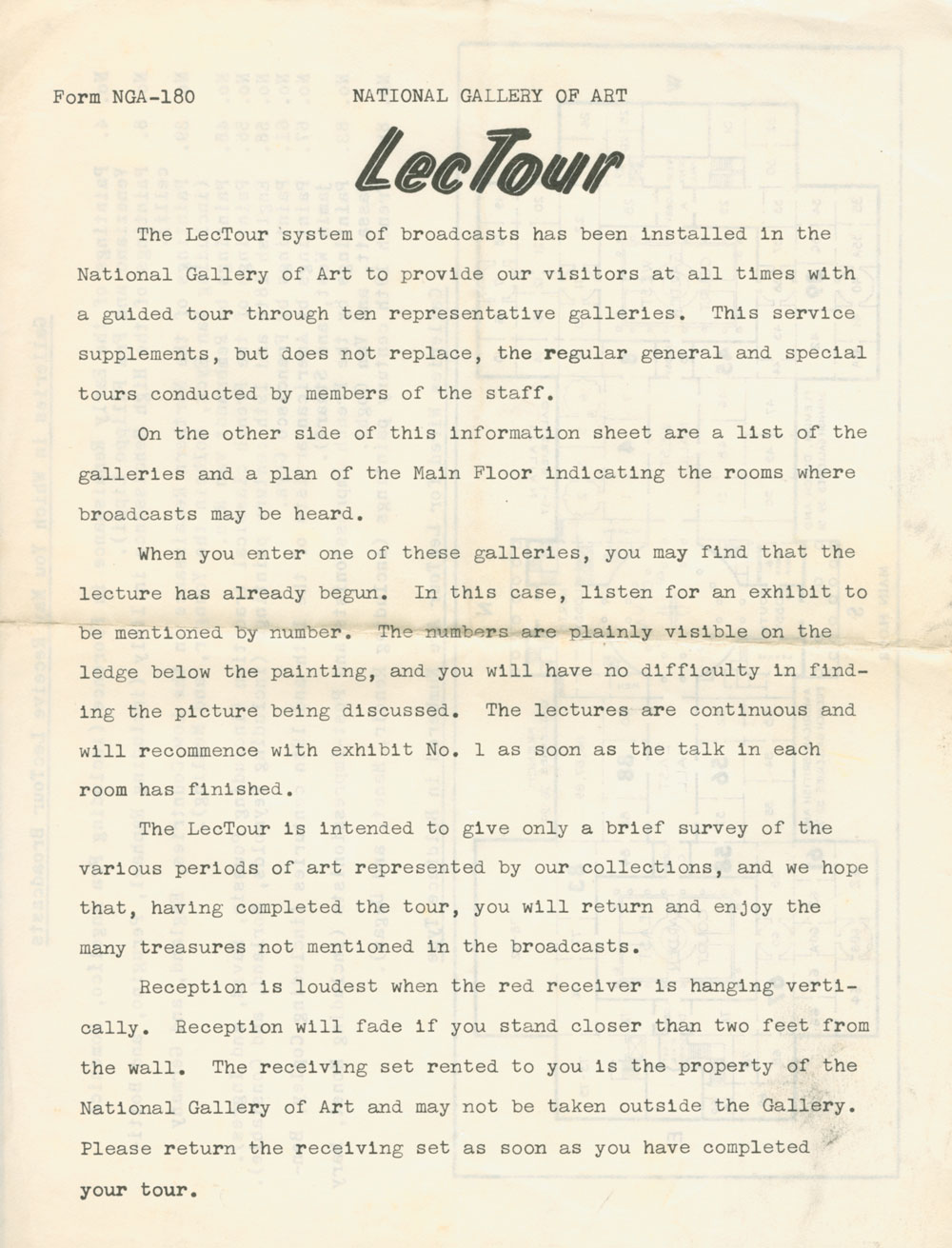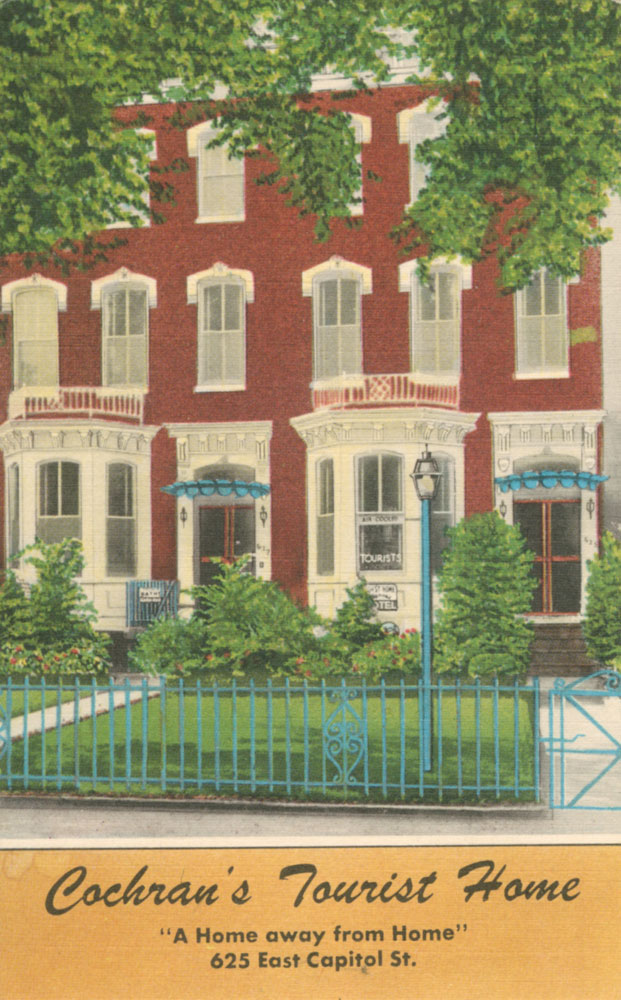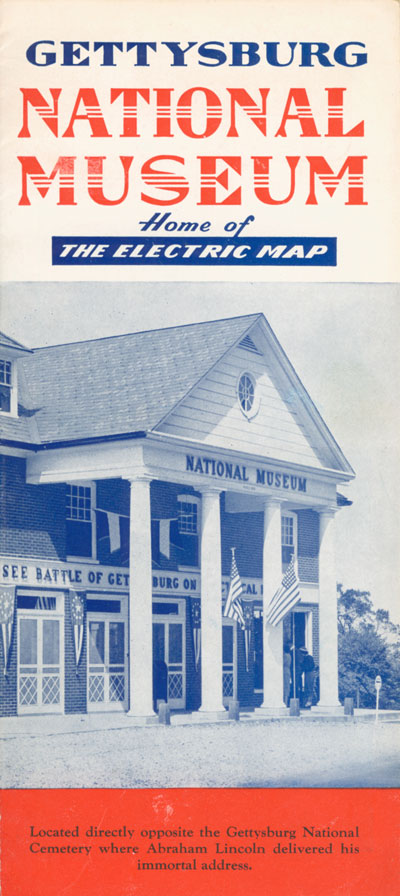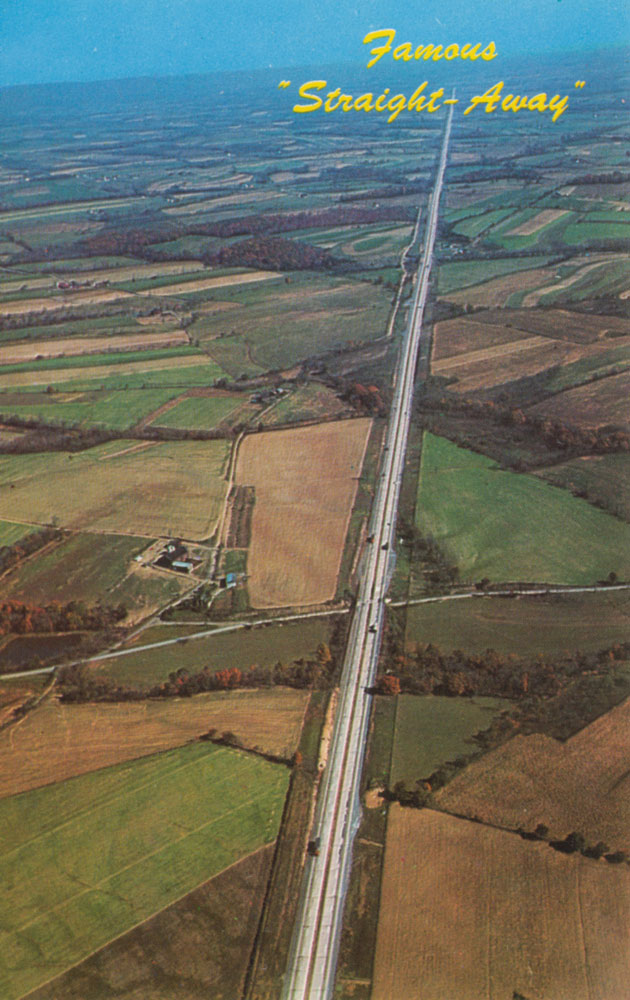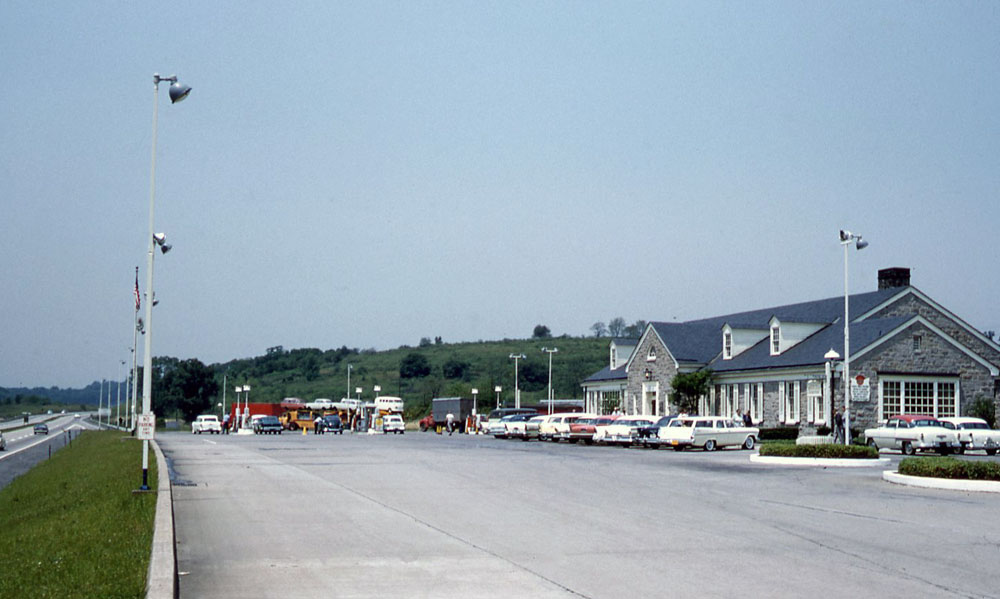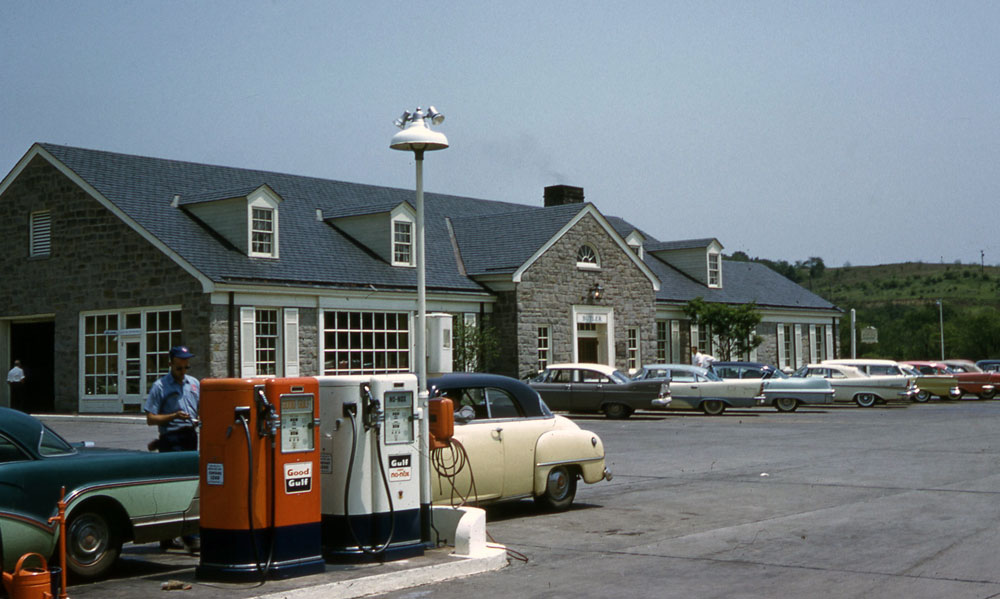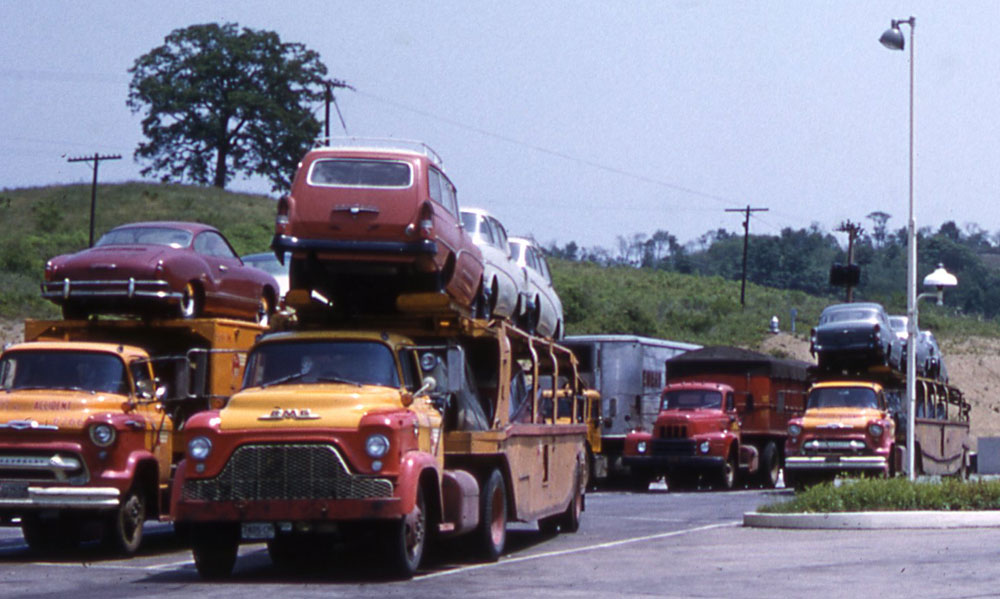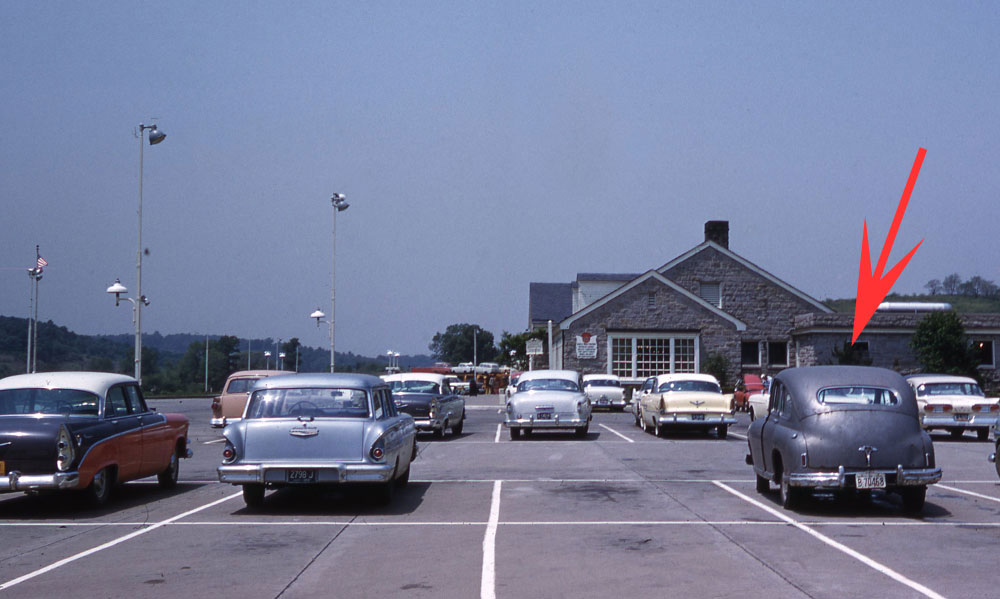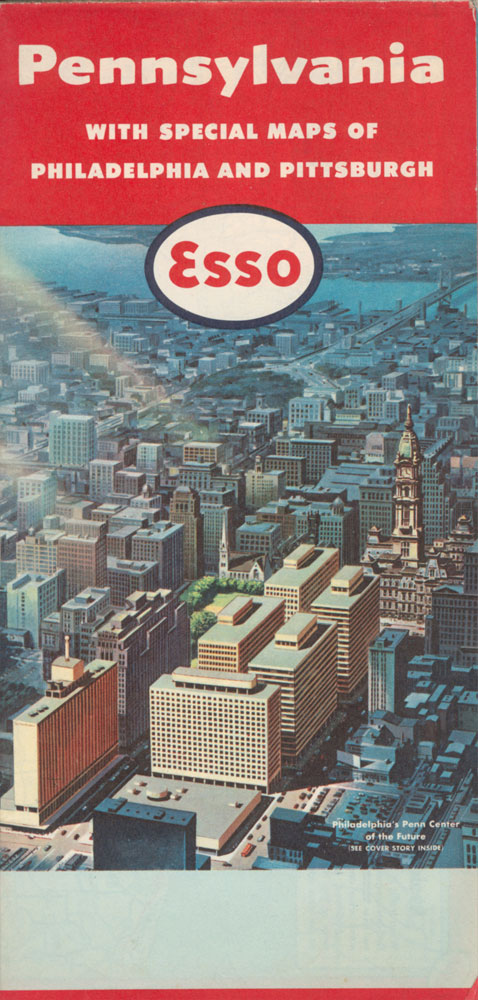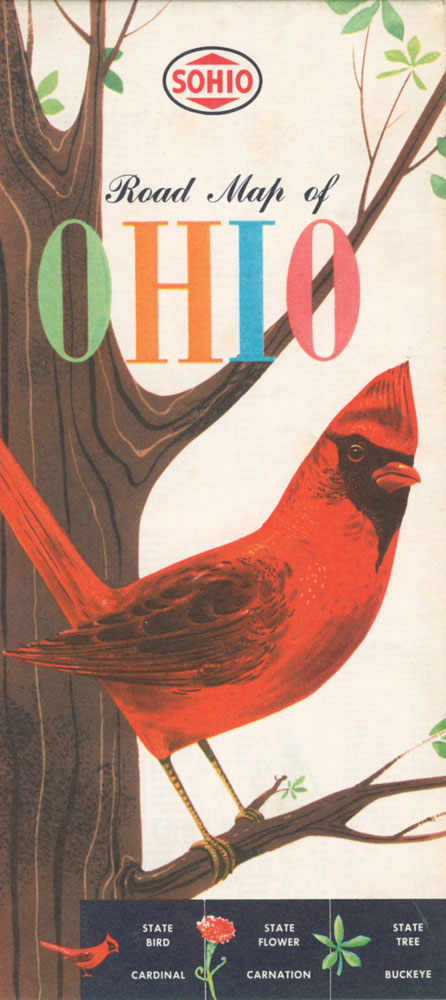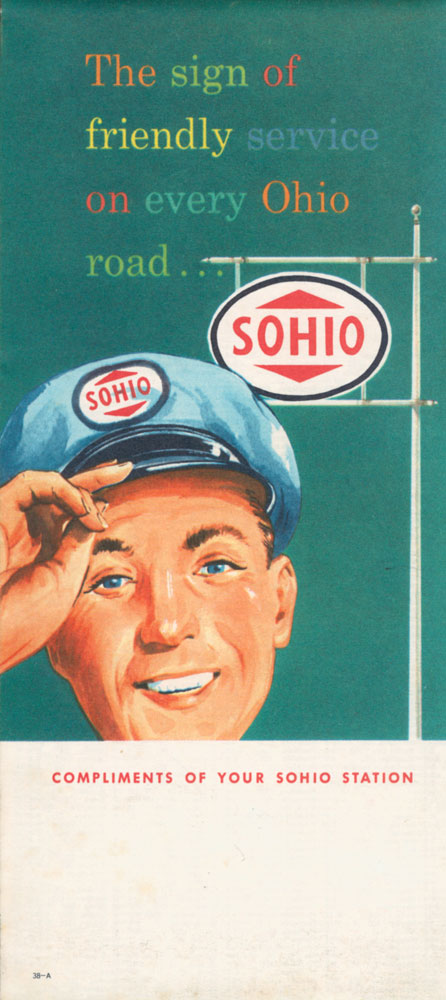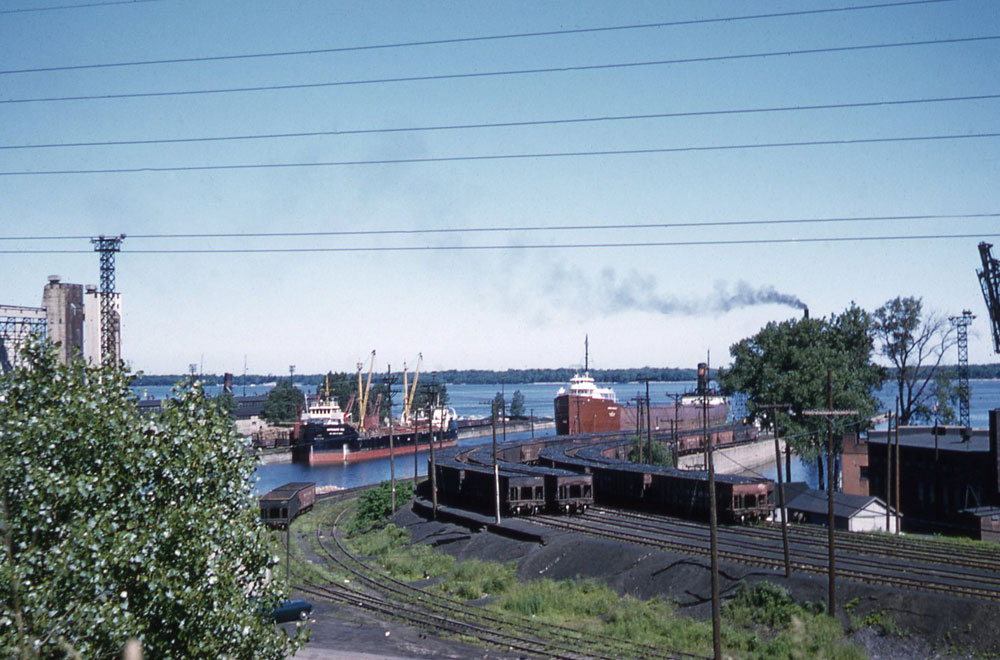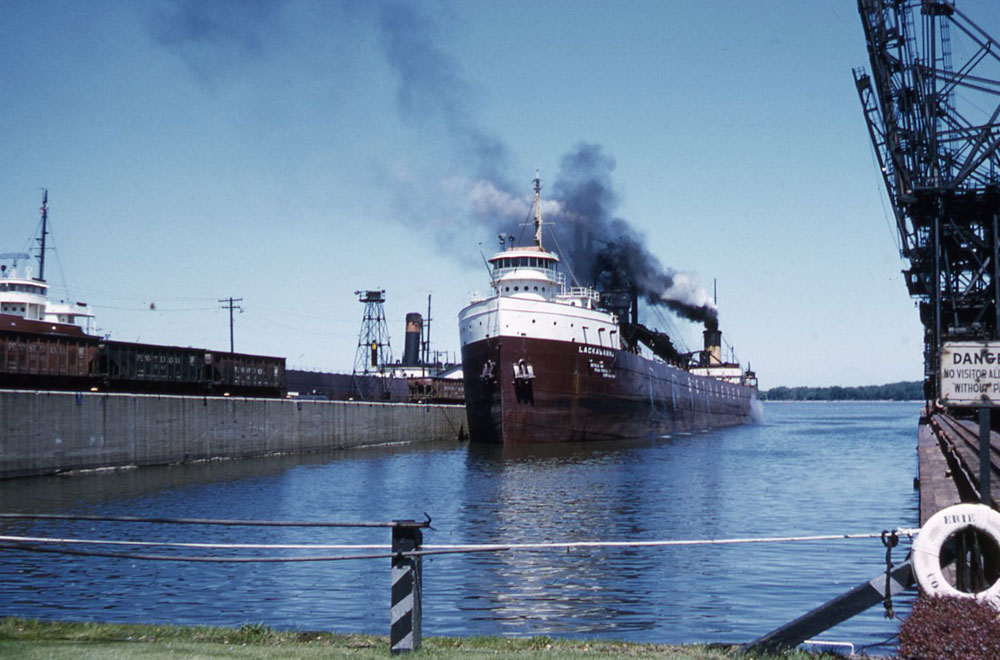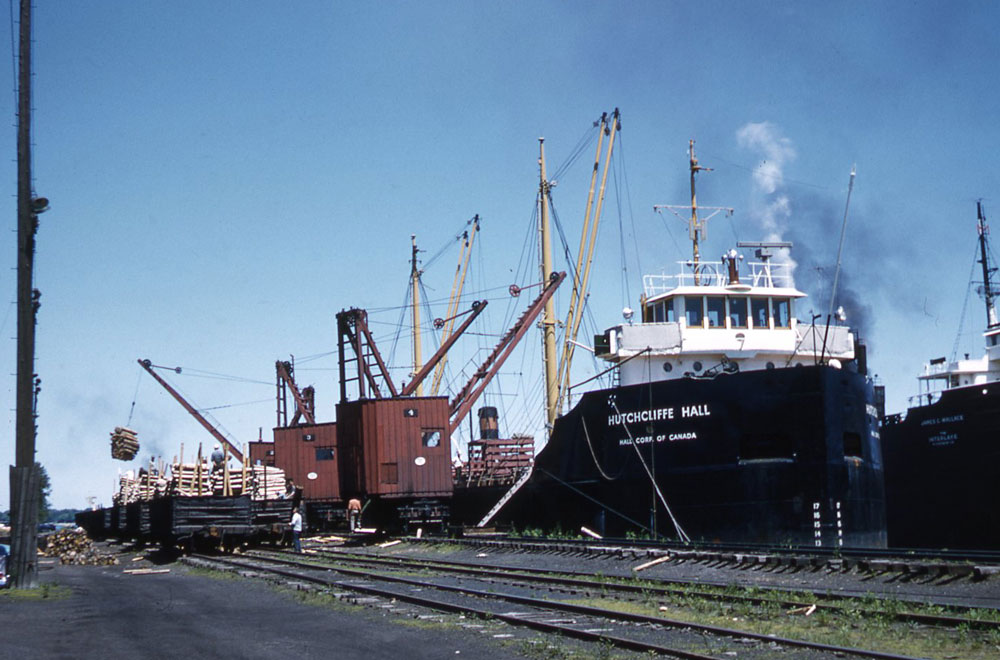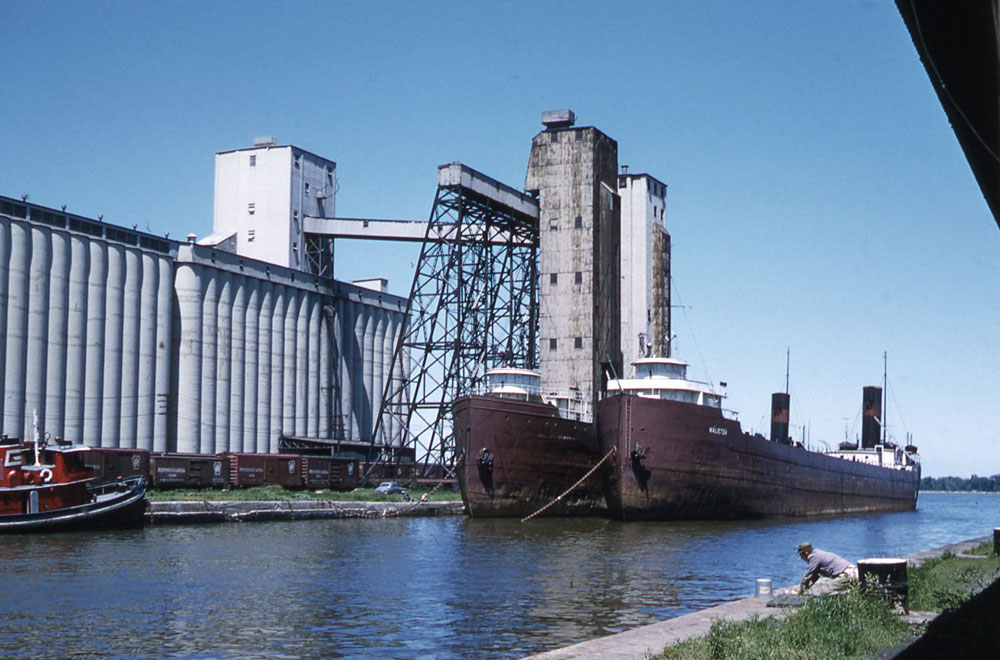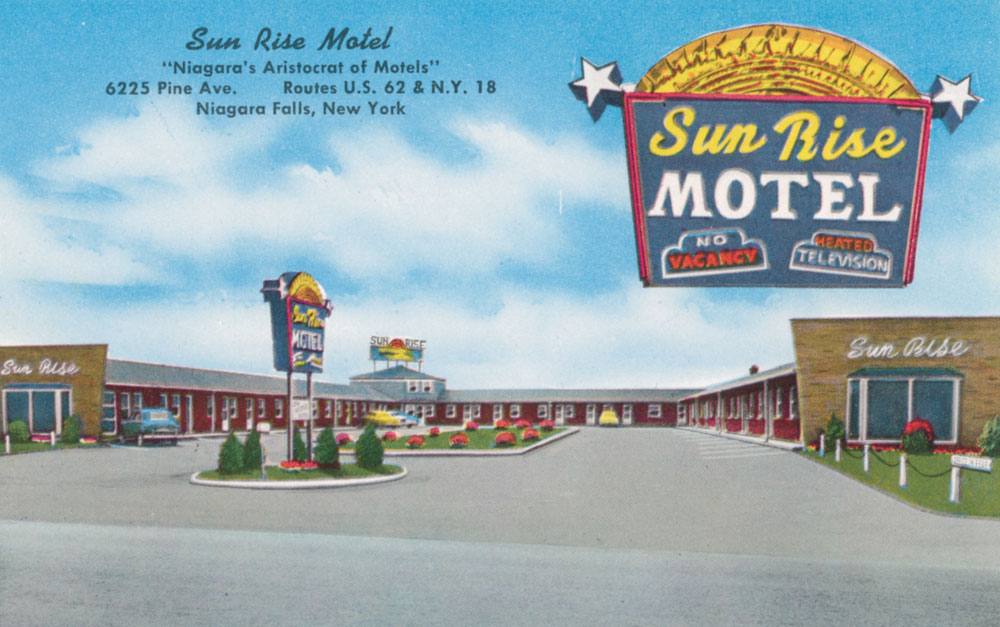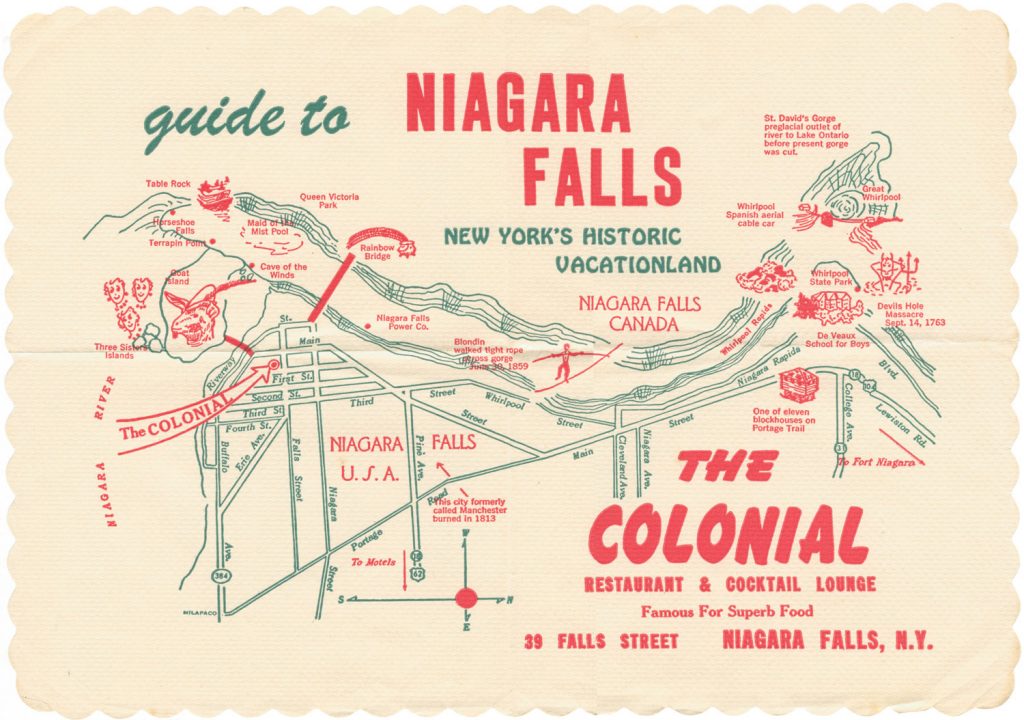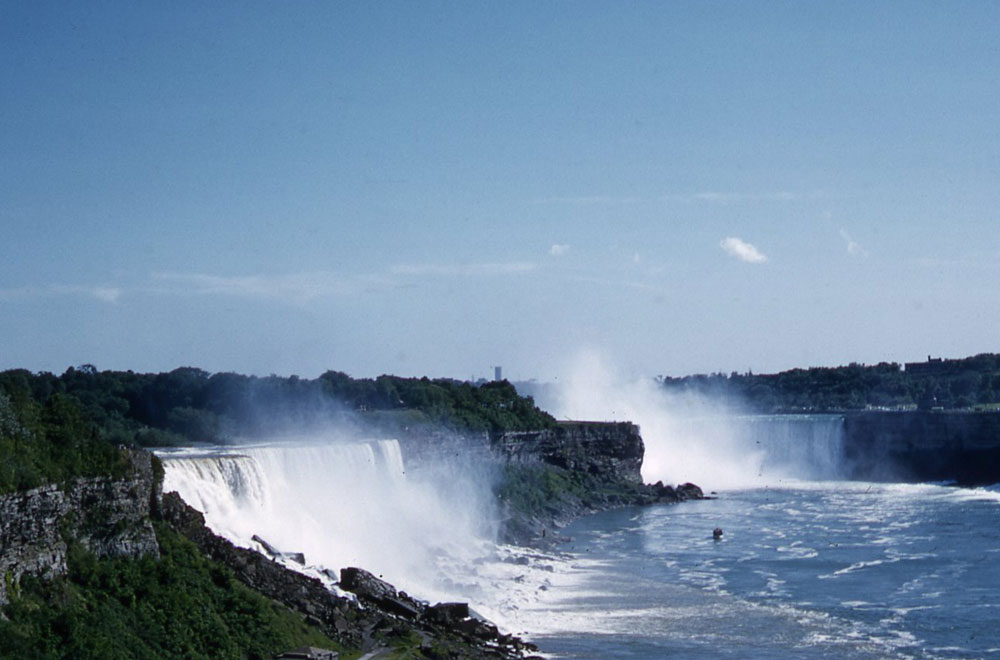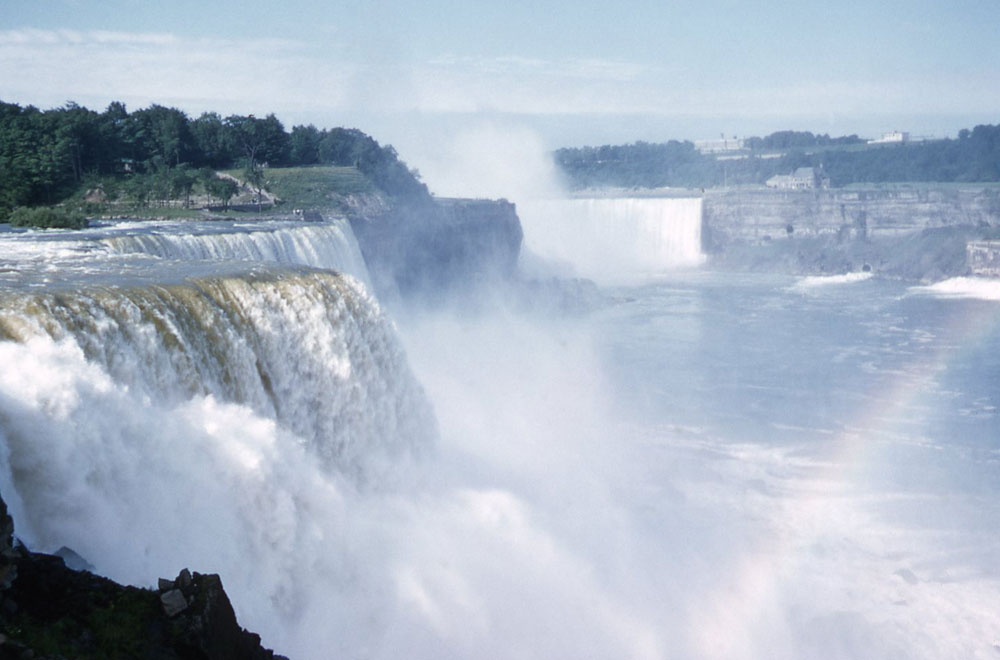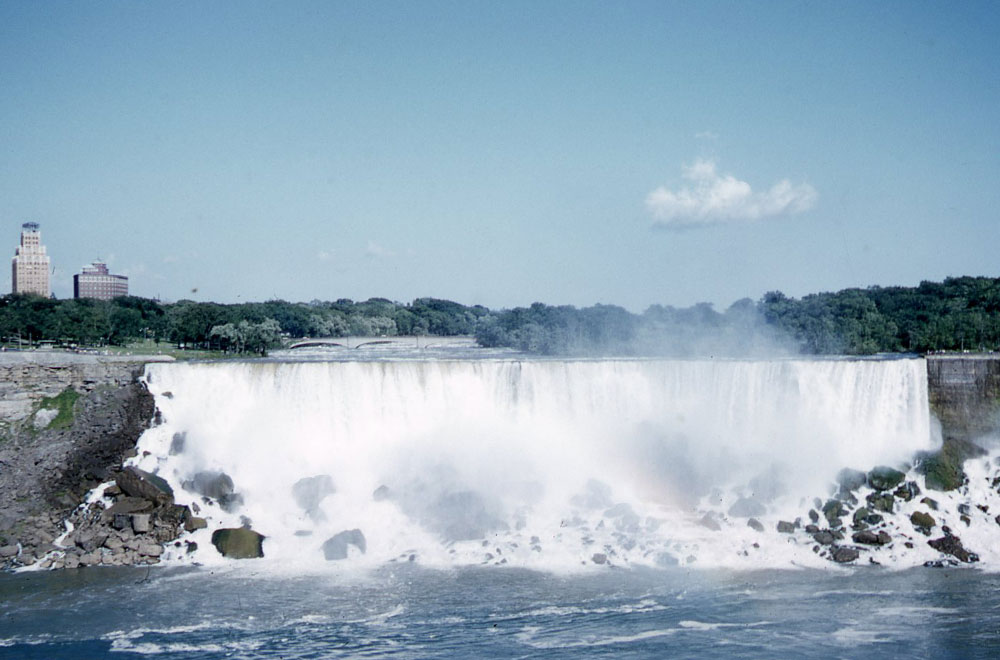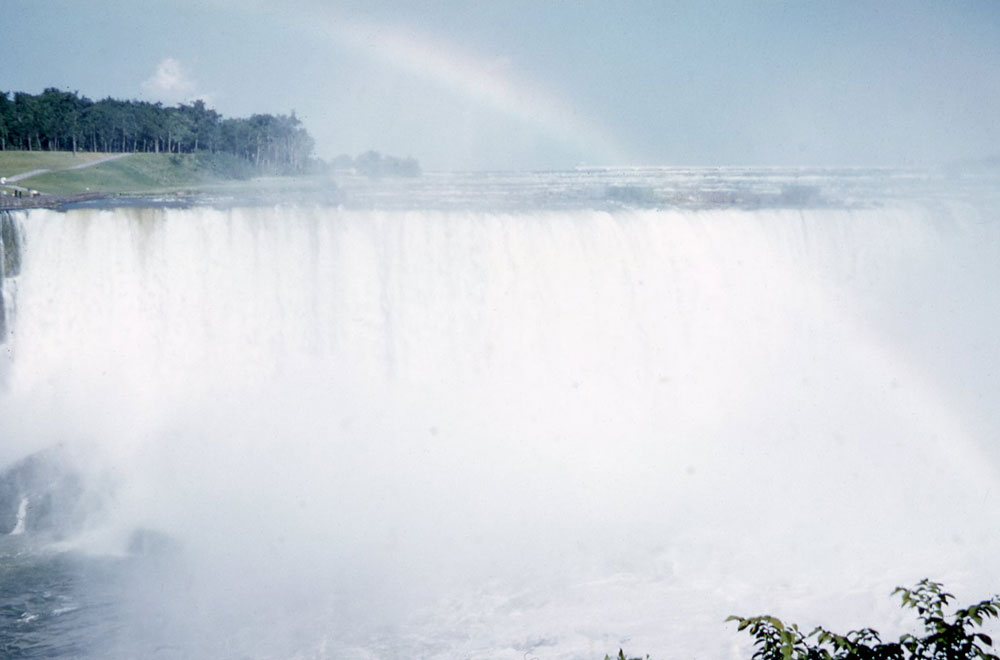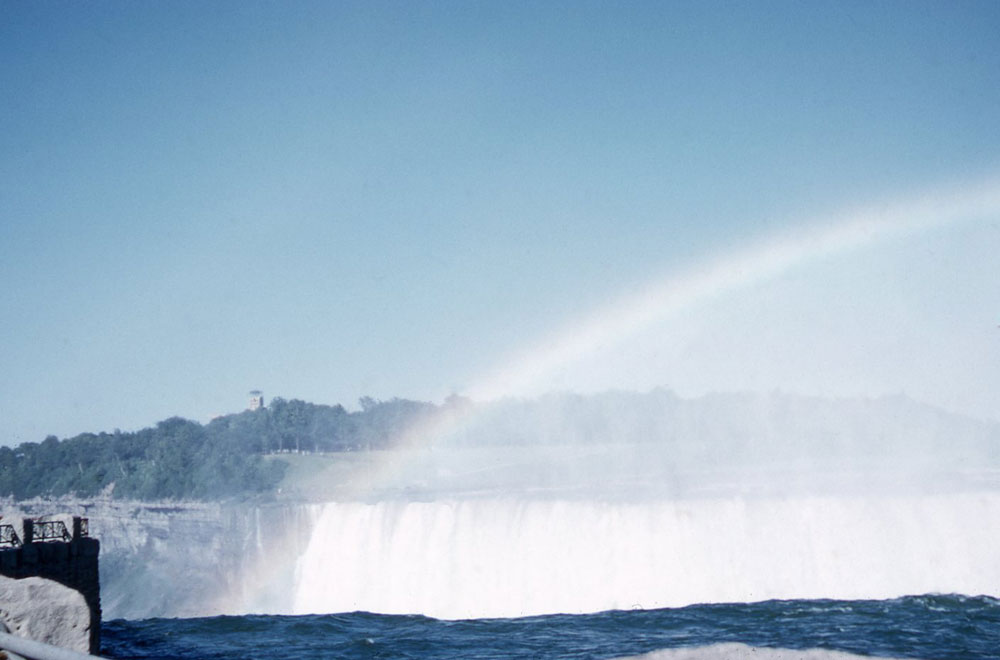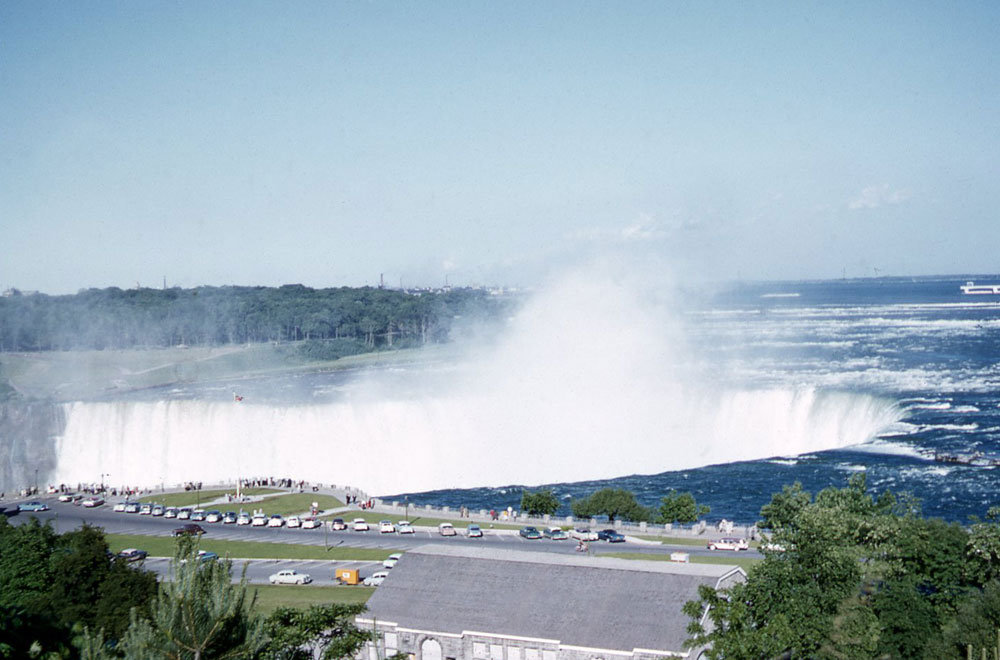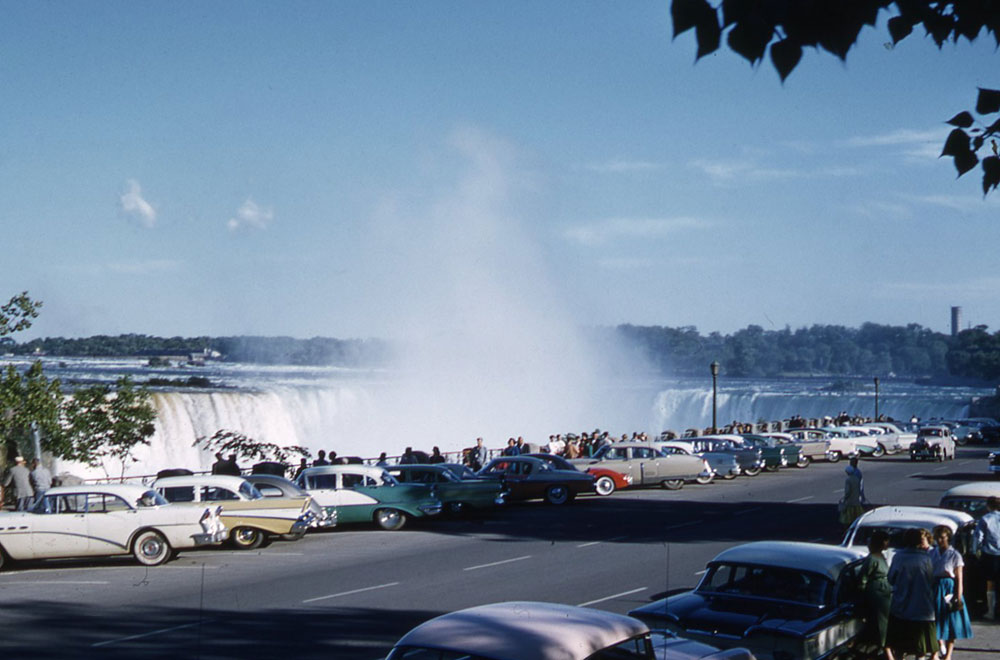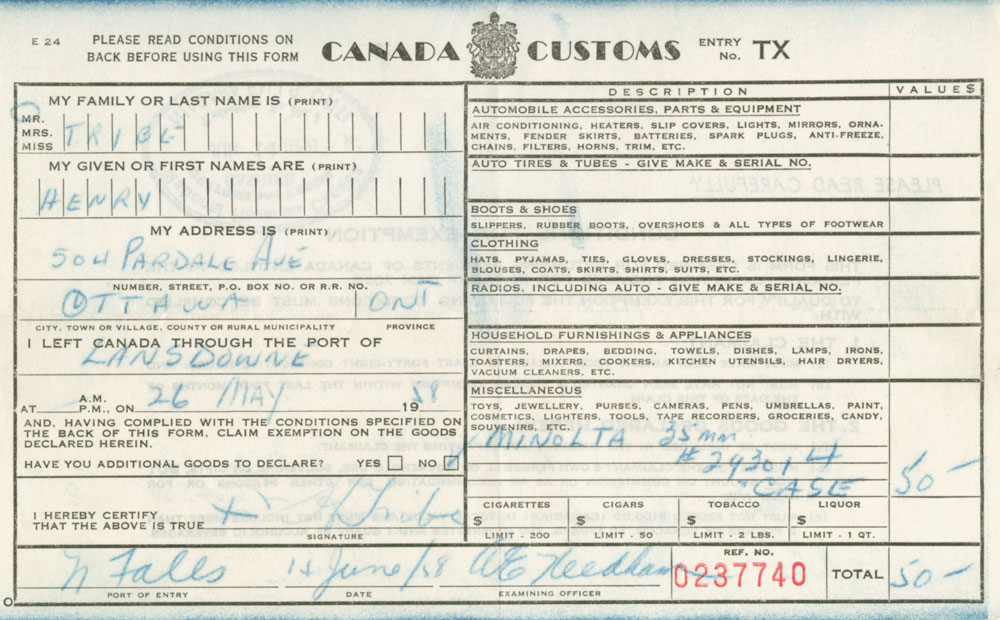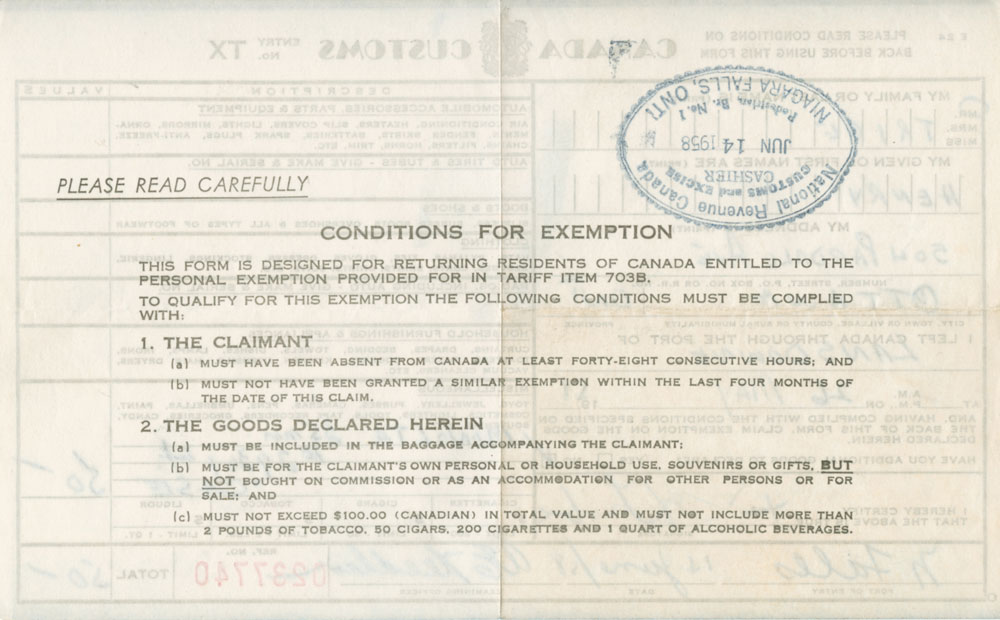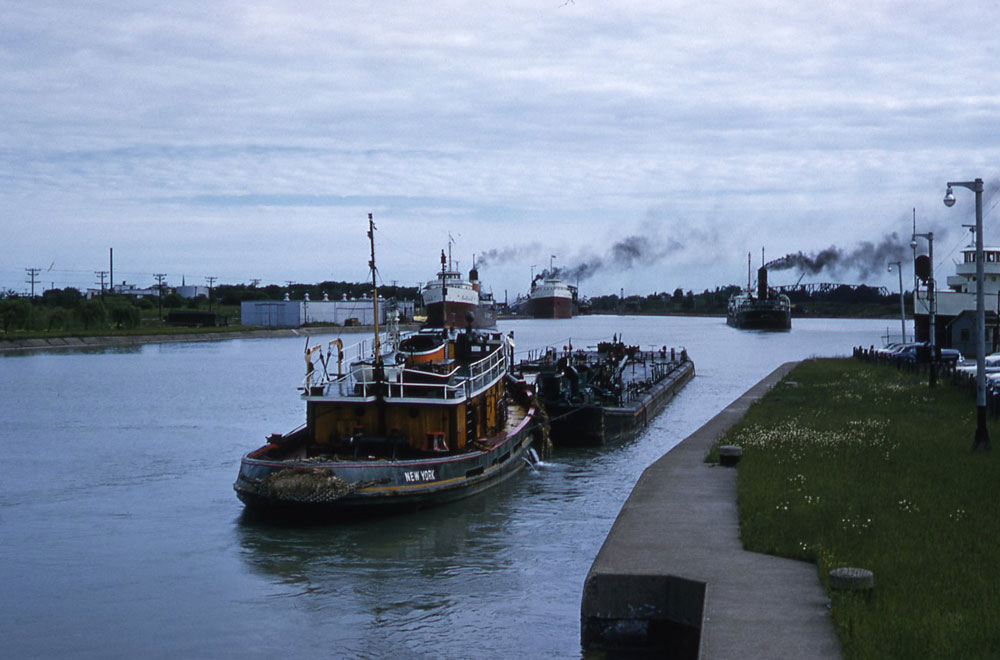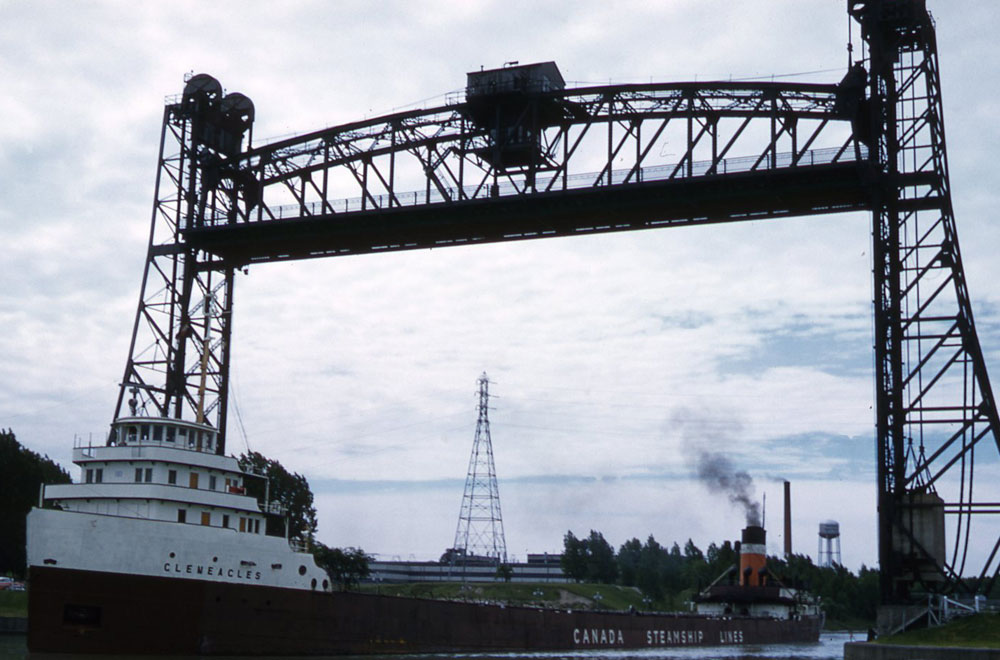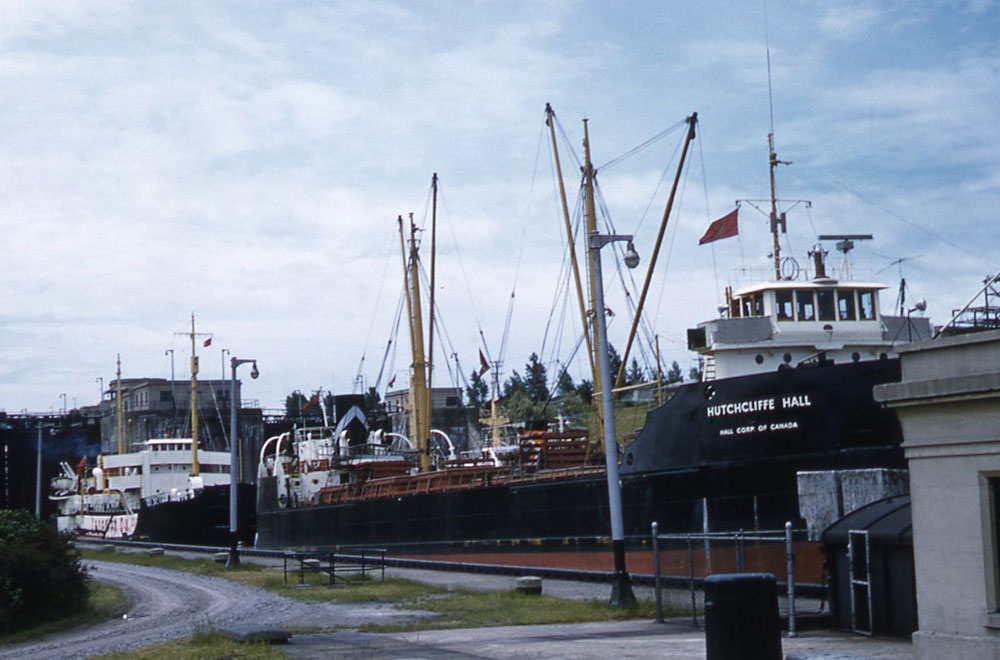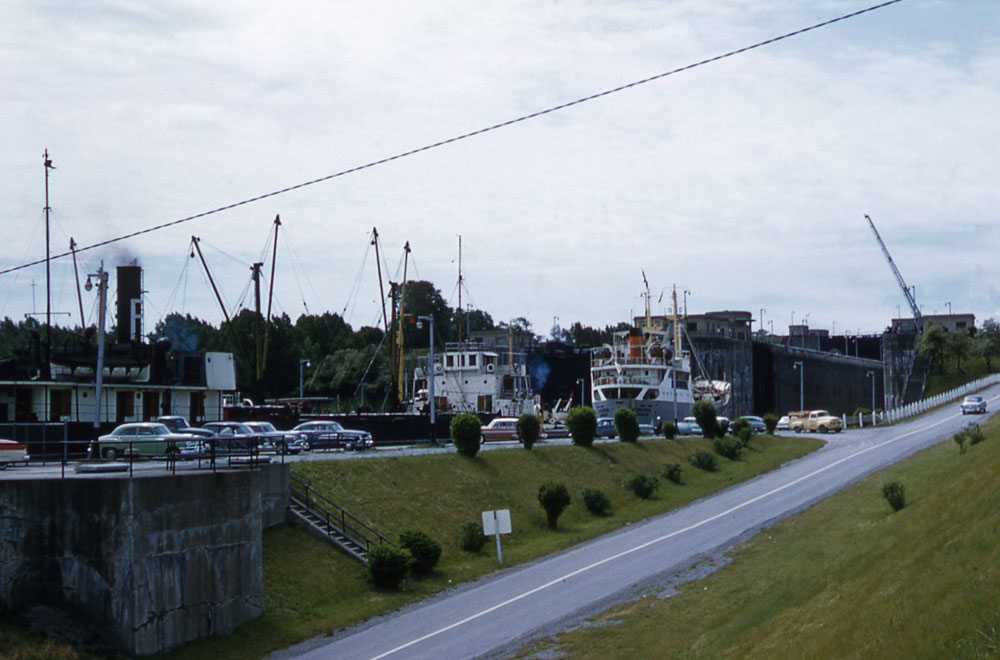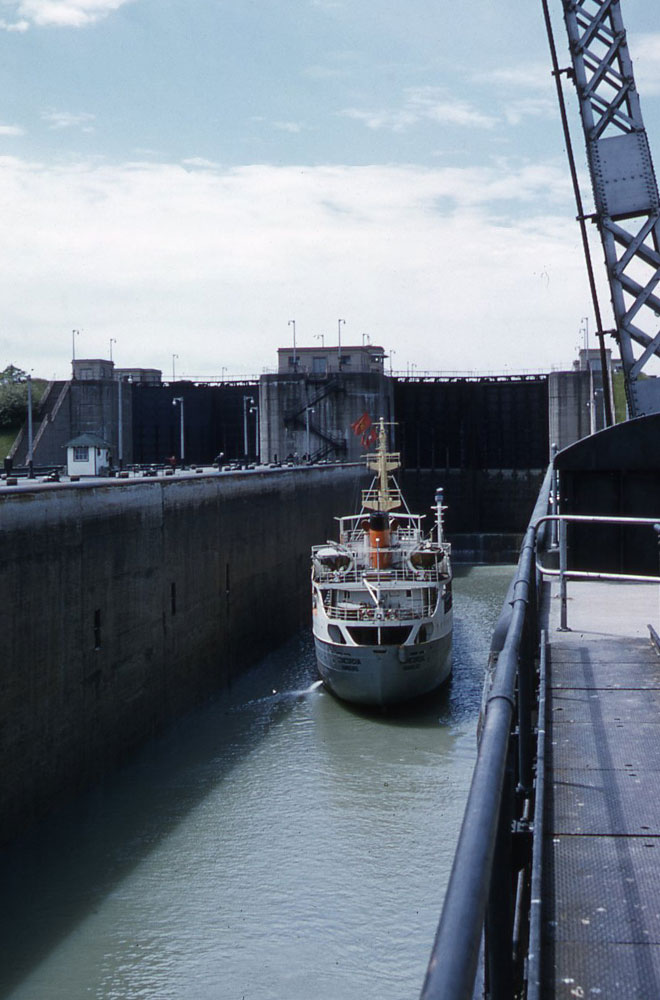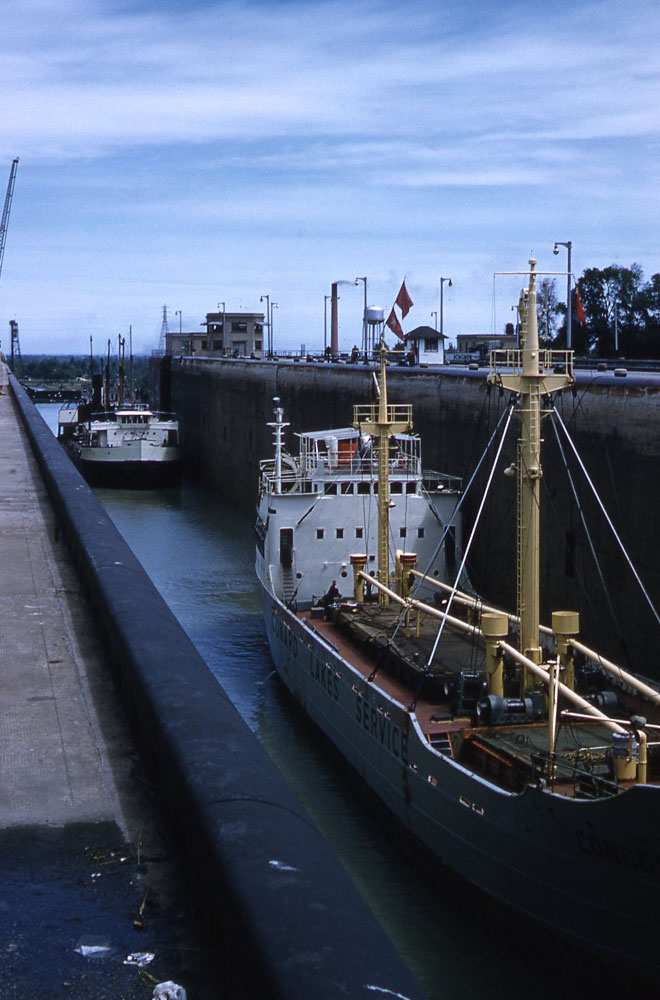USA Road Trip
Contents
Ithaca (Cornell University)
Princeton (Merck and Co. in Rahway, Rutgers University in New Brunswick, Bay Head, New York, Philadelphia)
Princeton to Washington, D.C. (New Jersey Turnpike, Edgewood Diner)
Washington, D.C. (Sightseeing, US Department of Agriculture at Beltonville)
Washington, D.C. to Warren, OH (Gettysburg, Pennsylvania Turnpike)
Warren, OH to Ottawa (Erie, Niagara Falls, Welland Canal)
Introduction
In May 1958, during his year in Canada, Henry went on a three week USA road trip in his Standard Vanguard car. The trip was part work and part holiday, visiting microbiologists and laboratories in the USA as well as sightseeing and visiting friends.
Part way through his his trip, Henry bought a Minolta camera and this page includes scans of some of the photographs (transparencies) he took with it.
The text is from the letters and postcards Henry wrote to his parents during and immediately after the trip.
Ottawa to Ithaca
The first stop on Henry’s road trip was Ithaca, a town at the southern tip of Cayuga Lake in the Finger Lakes region of New York State, where he was to meet soil microbiologist Martin Alexander in the Agronomy Department at Cornell University.

Monday May 26th
Ithaca is the first objective, and I arrived here about 6pm, it’s 260 miles from Ottawa. On the way I crossed over the St Lawrence River at the Thousand Islands Bridge, which is also the boundary between Canada and the US, it is where the St Lawrence leaves Lake Ontario. There are two large bridges, one Canadian and one American and the customs is a large island in between.
Ithaca

Monday May 26th
At Ithaca is an incredibly large university (Cornell University). All the labs in Cambridge occupy only a fraction of the space that they do here. Vast lawns separate the buildings here, the whole collection of university buildings (called a campus), according to the map, close on half a square mile. It is surprisingly hilly too, many streets like Oxford Grove in Ilfracombe, and at the edge of the University Campus a river flows down between a really deep gorge, such as one would expect to find miles from anywhere! I had a good look round after arriving here and spent more than two hours observing the buildings and the natural scenery. I was surprised to find the libraries still busy, at 8:30 lights were blazing in a number of departmental libraries, at least one of which was full of students. Despite what’s said in recent issues of the magazine “Life” about some American scholars taking things rather easily (compared with Russians, that is) – they were very busy here – perhaps exams are near? So much for first impressions. To-morrow I shall visit the Agronomy Dept., and now shall retire to bed, being very sleepy!

Tuesday May 27th
Spent a very interesting day at the Agronomy Dept., being shown round by the Assistant Professor, Dr Martin Alexander, a very friendly and learned person about my own age. He has a “United Nations” of graduate students working in his Department from Ireland, the Philippines, Pakistan, Australia, Costa Rica, the U.S.A. and Canada. Had considerable discussion with Dr Alexander and several of his students and he then showed me the University Campus and invited me back to his home for dinner. Afterwards he showed me around Ithaca and the surrounding hills of this very pleasant city, back for coffee and then he took me back to the hotel. Really no-one could have been more hospitable, and I shall always remember the first visit to a United States University. Again very sleepy, and shall retire forthwith!
Ithaca to Princeton
After Ithaca, Henry drove to Princeton, New Jersey. He doesn’t write about his journey to Princeton, however in his souvenir collection there are a number of Esso road maps with wonderful 1950s artwork. These maps were obtainable free of charge from service stations. One map, of New York State, bears a stamp from a service station at Willsayville N.Y., a town between Ithaca and Princeton. This map, and an unstamped one of New Jersey, are shown below (click to enlarge).
Princeton
In Princeton, Henry stayed with a friend called Grahame Rees, who had previously been a house-mate in Cambridge.
Using Princeton as a base, Henry visited Arnold Demain at Merck and Co. in Rahway and Robert Starkey and Selman Waksman at Rutgers University in New Brunswick. All three men were prominent microbiologists.
He also visited New York and Philadelphia and, at the invitation of Arnold Demain, Bay Head on the New Jersey coast.

Wednesday May 28th
Travelled to Princeton from Ithaca on Wednesday, and spent the evening with Grahame Rees who used to live at Mrs Miller’s in Tennison Avenue Cambridge. He is prospering over here and intending to stay for five years.

Thursday May 29th
On Thursday morning went to Merck’s and saw over the animal experiment and microbiological stations. I met a Dr Arnold Demain there whom I had first met in Ottawa, he had arranged for me to give a talk on cellulose decomposition studies, which I did after lunch. He invited me to stay for the evening, and the next day I visited New York.

Friday May 30th
I went into New York by bus, as it’s not very easy to find one’s way about in heavily built-up areas, and the buses to New York are fairly frequent. They also use the big toll roads, on which they travel at around 60 m.p.h., and also a toll tunnel under the river to Central New York, and the payment of these tolls for the car costs more than the bus fare.
The U.S. has a national holiday on Friday, 30th May, called Memorial Day, so much of New York was closed, but I explored the Greenwich Village district, which is very like Chelsea in London, and in the evening went to see a play by Arthur Miller called The Cruicible. David, as your ‘Art Critic’ may know of this, personally I did not enjoy it very much, being about a witch hunt in Massachusetts in 1692. Its topical interest is in paralleling the McCarthy communist witch hunts in the U.S. a year or so ago.
Dr Demain had invited me to stay at his home on the Friday night as well and to travel down on the Saturday to visit a summer cottage that a number of his friends jointly own on the coast of New Jersey. He had given me the key to his home to let myself in after visiting New York, since I should return late at night after the theatre! Really, the Americans I have met so far have been extremely hospitable.
Dr Demain lives in Westfield, a suburb of New Jersey, and has a new house on the outskirts. This part of New Jersey is very much attuned to the automobile, none of the roads in that district having any pavements to walk on – said to preserve a “rural” setting!! There were no buses in the suburb.

Saturday May 31st
On the Saturday I followed Dr Demain down by car to the New Jersey coast and spent a jolly evening with the group of young people at the cottage.

Sunday June 1st
This afternoon I’m spending on a sandy beach on the coast of New Jersey.

Monday June 2nd
This week has simply flown by. I stayed with Grahame Rees in Princeton fom Sunday to Thursday nights inclusive, and on Monday travelled the short distance to New Brunswick to see the Rutgers University Agricultural Microbiology Dept. I spent much of the day with Dr Starkey and his students discussing various aspects of soil microbiology.
While in Princeton, Henry took some transparencies of the University with his new camera:

Tuesday June 3rd
On the Tuesday I again went to New Brunswick to visit the Institute of Microbiology, built out of royalties from streptomycin production. In the morning I had arranged to give a talk to the staff and research students at Rutgers University, the same one as at Mercks. I thought it went down fairly well. Saw over the institute in the afternoon, and heard that there was to be a symposium on “Microbiology. Yesterday and Today” on Thursday, in celebration of the Institute Founder’s 70th birthday. To this function a number of eminent microbiologists from various places in the U.S.A. were invited, and I was very fortunate in being kindly found a ticket from someone who had cancelled.

Wednesday June 4th
Visited Philadelphia.

Thursday June 5th
The symposium was a most interesting meeting; one speaker had been invited from England, a Dr S. T. Cowan from the National Collection of Bacterial Type Cultures, Medical Research Council. Does Dad know a Dr Cowan? The last lecture on Aspects of Russian Microbiology was presented by a Russian who has been working at the Institute for several months. It was read by someone else, in English, and consisted chiefly of a eulogy of the contributions to science by Russian scientists and laboratories without specifying at all carefully what had been done. The meeting was followed by a dinner and then an address by the founder of the Institute (also its Director) Dr Waksman. A very memorable day.
Princeton to Washington, D.C.
After Princeton, Henry drove to Washington D.C. to visit the United States Department of Agriculture’s experimental station at Beltonville.

Friday June 6th, Saturday June 7th
Arrived in Washington back on Saturday morning, after an interesting journey from Princeton over some of the biggest roads in the U.S.A. First, to the south of New Jersey, I took the New Jersey Turnpike, a toll through road which avoids all towns. It’s an experience to travel on these roads; they are of course divided lane high-ways, and are completely separated from all other roads, which are crossed by tunnels or bridges. In about 80 miles of road which I travelled there are only 5 or 6 exits. Just like a railway system, with a speed limit however of 50 m.p.h. Then across the Delaware Memorial Bridge.
I stayed at a motel that night on the road to Washington – an expensive night, $6 (roughly £2.5.0) without breakfast. For this one has a beautifully furnished room complete with own shower, bath and basin and lav. Also air conditioning 50 cents extra – I did without this and opened the window.
On Saturday morning I did the last lap of the journey on to Washington, by-passing Baltimore by driving under the Baltimore Harbour Tunnel.
Below are some more Esso maps that Henry picked up at Elkton, M.D., between Princeton and Washington (click to enlarge).
Washington, D.C.

Saturday June 7th
A beautiful, open city is Washington, with many very fine white buildings. Went on a conducted tour of the city on the Saturday afternoon, and cruise down the Potomac River to Mount Vernon, George Washington’s home. This an extravagance – a piece of pure tourism.

Sunday June 8th
In the morning went to the Episcopal Church, a direct descendent of the C. of E., except in that prayers for the Royal Family were replaced by prayers for the President of the U.S.A.
On the Sunday explored the city on foot, and spent some time in the National Art Gallery. Found an ingenious “guide” system there. Certain galleries were wired for a special kind of radio reception. One borrowed a device consisting of a small loudspeaker which one fitted over one’s ear-hole(!) and a battery and aerial which hung down from one’s neck. On entering a gallery wired for the performance, a commentary on the paintings was spoken directly into one’s ear. It was being continuously recorded, so that if one entered when the commentator had got round to no. 5 he would mention this painting by number during his discourse and then go to the next one, then to the end, and start again at no. 1. No two galleries next to one another were so wired, presumably to exclude interference.

Monday June 9th, Tuesday June 10th
I have now spent a few days in this warm and humid city. Yesterday the temperature rose to 92oF, being the warmest day of the year here, and in the evening we had a long storm.
I spent yesterday and to-day visiting the soil science sections of the United States Department of Agriculture’s large experimental station at Beltonville, near here. To-day I joined a group of students for a morning tour of part of the department dealing with home economics, entomology and animal husbandry, which group is on a fairly extesive tour of the U.S. and consisted of people from Jamaica and China and India. I returned to the soils department in the afternoon where I had been asked if I would give a seminar on cellulose decomposition (!).
Have just returned from a wander round. The Capitol is floodlit at night, floodlit pure white, as beautiful as any building I’ve ever seen at night.
I bought a little 35mm colour camera for taking transparencies whilst in New Brunswick and have been taking a few shots here. The slides have to be sent away to be processed but are very little more expensive that black and white film, as no prints have to be made from them. The “negative” is positive, and is mounted directly.
Well dears, I must stop now, it being quite early but very sticky, and I’m going to have a shower before retiring to bed. Please excuse rather bad writing, but dressing table not very convenient. My room here is $3.50 per night and doesn’t run to a writing table. (!)
Washington, D.C. to Warren, OH
After Washington, Henry drove to Warren, OH to visit Ruth Parker and Brenda Stevens. They were the daughters of Henry’s parents’ Wimbledon neighbours and had emigrated to the USA. On the way he visited Gettysburg, before travelling along the Pennsylvania Turnpike, known as “America’s First Superhighway”.

Wednesday June 11th
After leaving Washington, I crossed the state of Pennsylvania by the magnificent Turnpike Road, after travelling through Maryland via Gettysburg, where the decisive battle of the American Civil War was fought. Gettysburg itself is just in Pennsylvania. The famous battlefield is covered with monuments to this regiment and to that, and there are several museums there. I visited one in which was advertised an “electric map”, and this turned out to be interesting. It is a relief map of the battlefield studded with coloured electric lamps, constructed by a historian. Several times during the day a lecture on the battle is given from a record and a demonstrator illustrates the course of the battle by switching on the appropriate coloured lights, so that one can plainly see the positions of the various troops during the course of the battle. There were numerous exhibits of shells and bullets etc. in the museum. I think the fact which struck me most was the date, 1863, and the amount of “progress” in the conduct of war in less than 100 years, from cavalry and muzzle loading guns to aeroplanes and atomic bombs.
From the museum I went along the Turnpike. This road is 360 miles long and is completely separate from other roads, except at interchanges which are usually some 15 miles apart from each other. It’s enclosed as thoroughly as a railway in England, the only entrances and exits being of the clover leaf type at the interchanges. It goes through the Allegheny Mountains, and in several places there are tunnels. Refreshments and petrol are only served at special stations, which are placed about 30 miles apart from each other. The highway has two lanes on each side of the dividing grass verge. Naturally it’s a toll road, and it costs about 1d per mile per car. I left the turnpike near a small place called Stanton, which I presume was once a farming village, and earns its living now chiefly from the motorists seeking a nights lodging from the Turnpike.
Below are transparencies that Henry took of the Butler Service Plaza (restaurant and filling station) on the Pennsylvania Turnpike (click to enlarge). The arrowed car is Henry’s Standard Vanguard. The Butler Servce Plaza was closed in 2002.
Below are more maps: Another Esso map, of Pennsylvania, and a map of Ohio from Sohio, an oil company that operated primarily in Ohio.
Warren, OH

Thursday June 12th
The next day I went on to Warren, Ohio, to visit Ruth and Brenda. I arrived at Ruth’s at about 3 o’clock – she had changed very little, I thought, though we calculated that perhaps apart from one or two chance meetings during the war we hadn’t seen each other since 1939! Nearly twenty years! Mr Parker and then Brenda came in a bit later, and after supper we went to the new Packard Mall in Warren to see the musical show “Showboat” which I for one enjoyed immensely. Mr Parker is a very good chap, very able too as a carpenter and gardener. He has constructed a beautiful little bedroom for the two boys in the attic, boarding out the rafters very skillfully indeed, and is in the process of constructing himself a study. Brenda looked very well indeed and is certainly enjoying life in Cleveland. She motored down from Cleveland in a very superior little car, and had to motor back before work on the following morning. The next day the boys were rather interested in cameras, so before I left we had a little competition taking pictures with my snapshot camera. The little girls enjoyed this too, and seemed to enjoy both posing for their pictures and taking pictures. The smallest one, Margaret Ruth, pressed the button twice for good measure and hers have come out double! I have just had them developed and am going to send on the better ones and some candies (sweets) for the prize!
Unfortunately, we have not (yet!) found any prints or negatives of the photographs mentioned in Henry’s account above.
Warren, OH to Ottawa

Friday June 13th
From Warren I travelled along Lake Erie to the town of Erie, where I spent the night and where I took some colour pictures of shipping, and on to Niagara Falls on the Saturday.
Below are the transparencies Henry took of shipping at Erie Harbour.

Saturday June 14th
On the way [to Niagara Falls], part of the busy town of Buffalo is by-passed by a “skyway”, where the road is carried over the top of the town. Niagara was really magnificent. The sun was shining fairly strongly, and I took some colour transparencies of the Falls with bright rainbows in the spray. Hope they come out all right! At night the Falls were floodlit in vile green and crimson light.
Below are Henry’s transparencies of the Niagara Falls. Henry later noted that on the transparencies “the rainbow at Niagara was a pale shadow of the real glory”!
At Niagara Falls, Henry crossed the border back into Canada. Below is the customs declaration for the Minolta Camera he bought in New Brunswick:

Sunday June 15th
On the Sunday I returned to Ottawa, after having a good look at the Welland Canal, where ships are lifted by a series of locks from Lake Ontario to Lake Erie. Passed through Toronto on the way, but didn’t stop to look at it, the journey from Niagara to Ottawa being over 300 miles.
Below are the transparencies Henry took of the Welland Canal.
Back in Ottawa

Sunday June 15th
I arrived back in Ottawa late on Sunday night, ending one of the most pleasant trips I’ve ever gone on. The mileage indicator showed that 2,050 miles had passed since I left Ottawa on 26th May, which just goes to show how far one can travel on a trip which on a map of the U.S.A., doesn’t look very long. The car behaved very well, had to have the brakes adjusted once, but otherwise uneventful.
Was much luckier on my trip for weather than if I’d been in Ottawa! Had only one wet day, whilst Ottawa has had a cool wet month, the coldest June so far for years.
Thus ended the “Smaller Tour”. Things seem to be crystallising out a bit now, and for my holiday I’m thinking of taking a trip, (by train! – note distances!) to the West Coast, at Vancouver. I’m told that for a little extra fare one can return via California and New Orleans. But that’s still in the future, though my time is beginning to run low.

Tuesday July 8th
Yesterday evening I went round to a friend’s and saw my coloured slides from the new camera projected for the first time. I am very pleased with the camera, the transparencies are very sharp and the colours brilliant. The rainbow at Niagara was a pale shadow of the real glory though!
[Return to top of page.]
[Return to main Abroad page.]
[Return to main Life page.]

